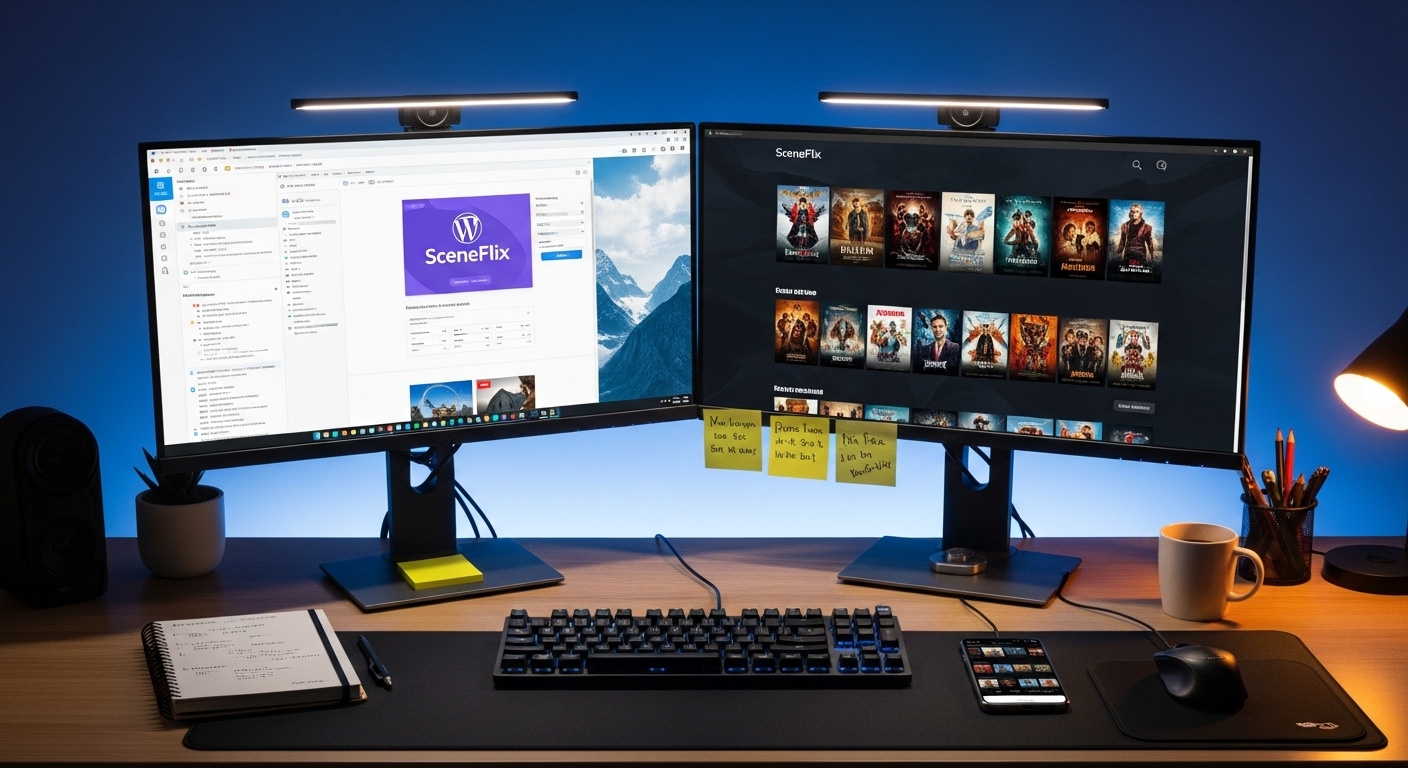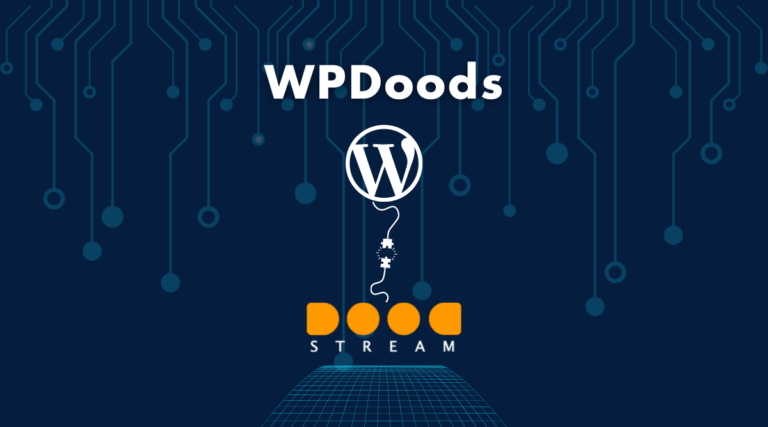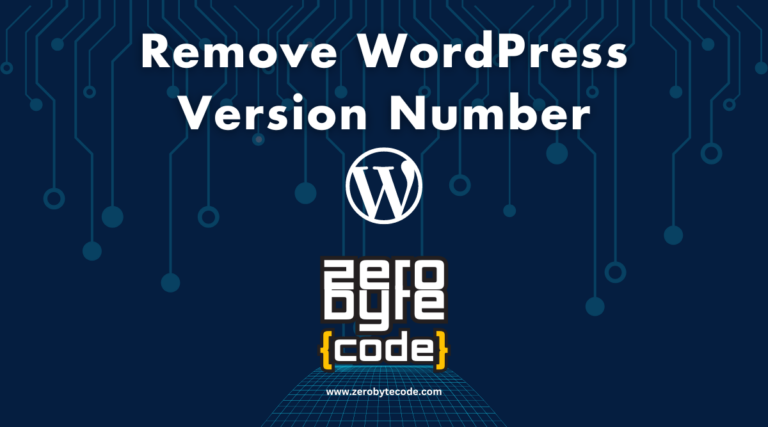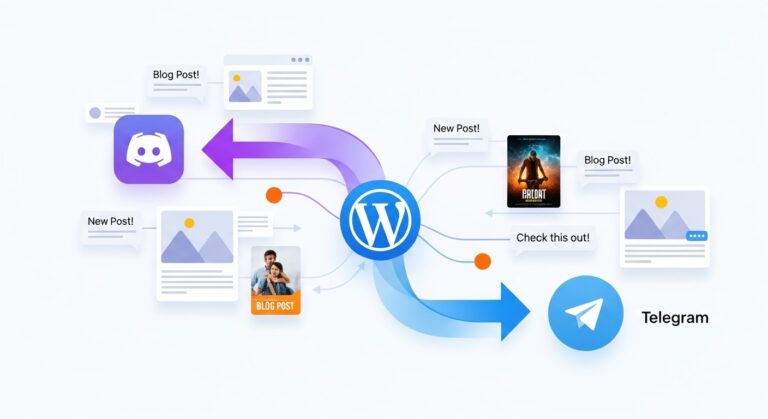How to Create a Movie Streaming Website With WordPress and TMDB API Using SceneFlix
SceneFlix transforms WordPress into a professional streaming platform by automating TMDB API integration for accessing over 800,000 movies and 200,000 TV series.
- Understanding the Power of Movie Streaming Platforms in 2025
- Getting Started with TMDB API: Your Gateway to Unlimited Movie and TV Content
- Creating Your Free TMDB Developer Account Step by Step
- Understanding API Rate Limits and Best Practices for Content Fetching
- Security Considerations When Working with API Keys
- Understanding WordPress as a Streaming Platform Foundation
- Server Specifications and Hosting Recommendations
- Plugin Dependencies and WordPress Version Requirements
- Security Measures for Protecting Your Content and User Data
- Introducing SceneFlix: The Complete WordPress Bundle for Streaming Platforms
- Automated TMDB Integration and Content Synchronization Features
- Custom Post Types for Movies and TV Series Management
- Advanced Metadata Handling and Content Organization Tools
- Modern Responsive Design That Works on All Devices
- Customizable Homepage Layouts and Content Display Options
- Advanced Search and Filtering Capabilities for Better User Experience
- Installing and Configuring SceneFlix for Maximum Performance
- WordPress Configuration Optimizations for Media Streaming
- Database Setup and Performance Tuning Recommendations
- Installing Required Dependencies and Third-Party Plugins
- Configuring Your TMDB API Keys for Automated Content Fetching
- Understanding Language Settings and Multi-Regional Content Support
- Setting Up Automated Content Import Schedules
- Logo Upload and Branding Configuration Options
- Color Schemes and Typography Customization
- Homepage Layout Configuration and Featured Content Setup
- Building Your Content Library with Automated TMDB Integration
- Selecting Popular Movies and Trending Content for Initial Import
- Managing Genre Classifications and Content Categories
- Handling Movie Posters, Backdrops, and Promotional Images
- Season and Episode Organization Systems
- Automated Episode Updates and New Release Notifications
- Creating Binge-Watching Experiences with Proper Navigation
- Reviewing and Editing Automatically Imported Content
- Adding Custom Descriptions and Editorial Reviews
- Managing Content Ratings and Age Classifications
- Configuring Streaming Sources and Video Content Delivery
- Configuring Primary and Backup Streaming Sources
- Using Dynamic URL Parameters for Flexible Content Delivery
- Managing Different Video Quality Options and User Preferences
- Customizing the Video Player Interface and Controls
- Adding Subtitle Support and Multiple Language Options
- Creating Seamless Episode Navigation for TV Series
- Monetizing Your Streaming Platform with Advanced Advertisement Features
- Homepage Banner Ads and Featured Content Promotions
- Pre-Roll Video Ads and Bumper Advertisement Configuration
- Sidebar and Footer Advertisement Zones
- Image Banner Advertisements with Click-Through Tracking
- Custom HTML and JavaScript Advertisement Integration
- Video Advertisement Management and Rotation Systems
- Balancing Revenue Generation with User Satisfaction
- Creating Premium Ad-Free User Experiences
- A/B Testing Advertisement Positions for Better Performance
- Search Engine Optimization and Content Discovery Features
- Schema Markup for Rich Search Results and Featured Snippets
- Optimizing Movie and TV Show Pages for Search Engines
- Creating SEO-Friendly URL Structures and Navigation
- Advanced Internal Search with Filters and Sorting Options
- Related Content Recommendations and Cross-Promotion
- Popular and Trending Content Sections
- Managing User Experience and Platform Performance
- Mobile-First Design Principles for Streaming Platforms
- Touch-Friendly Controls and Gesture-Based Navigation
- Loading Speed Optimization for Better User Retention
- Watchlist Functionality and User Account Management
- Progress Tracking and Resume Watching Capabilities
- Social Sharing Features and Community Integration
- Scaling Your Platform and Advanced Customization Options
- Database Optimization and Caching Strategies
- CDN Integration for Global Content Delivery
- Server Resource Management and Scaling Considerations
- Custom CSS and JavaScript Integration Options
- Theme Customization and Child Theme Development
- Plugin Extension Possibilities and Custom Feature Development
- Launching Your Streaming Platform and Marketing Strategies
- Content Verification and Link Testing Procedures
- Cross-Browser and Device Compatibility Testing
- Performance Testing Under Different Load Conditions
- SEO Strategies for Competing with Established Streaming Services
- Social Media Marketing and Content Promotion Techniques
- Building an Audience and Creating Community Around Your Platform
- Ready to Build Your Own Movie Streaming Site With WordPress and TMDB?
- Wrapping Up
The plugin creates custom post types for movies and TV shows, implements automated metadata synchronization, and generates Netflix-inspired interfaces with responsive carousels and AJAX-driven search functionality.
Technical requirements include WordPress version 6.5+, PHP 7.4+, MySQL 5.7+, and 8GB+ RAM for peak performance.
Advanced database optimization and CDN integration ensure scalable deployment capable of handling millions of users with enterprise-level content management capabilities.
TL;DR
Hide- SceneFlix automates TMDB API integration with WordPress, eliminating manual content entry for 800,000+ movies and 200,000+ TV series.
- The platform provides Netflix-inspired interface with responsive carousels, filtering, and automated metadata synchronization for streamlined setup.
- WordPress foundation enables multiple revenue streams through subscriptions, advertising, and affiliate partnerships with full control over monetization.
- Technical requirements include PHP 7.4+, MySQL 5.7+, multi-core CPU, 8GB+ RAM, and SEO plugins like Yoast SEO or Rankmath.
- API security implemented through backend PHP requests, secure wp-config.php storage, and regular credential rotation with access controls.
Understanding the Power of Movie Streaming Platforms in 2025

The global video streaming market’s exponential growth to $184.27 billion by 2027 creates unprecedented opportunities for developers to implement custom streaming solutions using WordPress infrastructure and TMDB API integration.
Independent streaming platforms now capture significant market share by targeting niche audiences with specialized content libraries, generating revenue through subscription models, advertisement placement, and premium content access.
How to Build a Japanese AV Website Using WordPress and WPJav
Learn the essential steps to create a Japanese AV website with WordPress and WPJav, but beware ... Read More
Modern streaming architectures built on WordPress provide cost-effective scalability while maintaining full control over user data, monetization strategies, and content distribution workflows.
The Rise of On-Demand Video Content and What It Means for Content Creators
Modern streaming platforms have fundamentally altered content consumption patterns, creating unprecedented opportunities for independent creators to establish profitable video distribution channels.
The on-demand video market has shifted from centralized broadcasting to decentralized content ecosystems where creators can directly monetize their media libraries.
This transformation enables entrepreneurs to create movie streaming websites that compete with established platforms by leveraging, with the help of, automated content management systems and API integrations.
Technical implementation barriers have significantly decreased through WordPress-based solutions that integrate TMDB databases, allowing creators to deploy sophisticated streaming infrastructures without extensive development resources.
Content creators can now establish revenue-generating platforms through strategic advertisement placement, subscription models, and premium content tiers while maintaining complete control over their distribution channels and audience engagement metrics.
Why Building Your Own Streaming Platform Makes Business Sense in 2025
While traditional streaming giants dominate market share through massive content acquisition budgets, independent platform deployment presents compelling economic advantages through reduced operational overhead and granular revenue control mechanisms.
Building a streaming website using WordPress and TMDB API eliminates licensing fees while providing complete monetization flexibility.
The SceneFlix implementation enables developers to create free movie website architectures that scale efficiently without enterprise-level infrastructure costs.
Strategic Advantages for Independent Developers:
- Zero Content Licensing Fees – Eliminate millions in content acquisition costs through TMDB integration
- Complete Revenue Control – Implement custom advertising, subscription, or premium access models without platform restrictions
- Rapid Market Entry – Deploy functional streaming platforms within hours instead of years of development cycles
- Scalable Architecture – WordPress ecosystem supports millions of concurrent users with proper optimization strategies
Market Opportunities and Revenue Potential for Independent Streaming Services
SceneFlix’s TMDB integration enables rapid content library deployment, reducing time-to-market from months to days.
Revenue potential spans multiple streams: premium subscriptions, programmatic advertising, affiliate partnerships, and white-label licensing.
Independent platforms achieve higher profit margins through automated content curation and reduced licensing overhead.
The WordPress foundation provides cost-effective scaling, enabling operators to capture market share while maintaining operational efficiency and technical flexibility unavailable to corporate entities.
Getting Started with TMDB API: Your Gateway to Unlimited Movie and TV Content
The Movie Database (TMDB) API serves as the foundational data source for modern streaming platforms, providing programmatic access to over 800,000 movies and 200,000 TV series with detailed metadata including cast information, plot summaries, high-resolution artwork, and real-time ratings.
TMDB’s RESTful API architecture delivers structured JSON responses with consistent data formatting, making it the best choice for developers building scalable content management systems that require reliable, standardized movie and television data.
Establishing a TMDB developer account and generating API keys represents the critical first step in implementing automated content fetching and synchronization workflows within the SceneFlix WordPress framework.
What Makes TMDB the Perfect Content Database for Streaming Platforms
When developers evaluate content databases for streaming platforms, TMDB (The Movie Database) emerges as the definitive solution due to its all-encompassing API architecture, extensive metadata coverage, and developer-friendly implementation.
The TMDB API delivers exhaustive data structures encompassing cast information, crew details, plot summaries, high-resolution imagery, and real-time content updates across multiple languages.
SceneFlix leverages TMDB’s robust infrastructure to transform WordPress installations into professional streaming platforms through automated content synchronization and intelligent data mapping.
The content database provides exceptional reliability with standardized JSON responses, comprehensive error handling, and consistent data formatting.
- 800,000+ movies with complete metadata and imagery
- 200,000+ TV series including episode-level information
- 50+ languages supporting global audience requirements
- Real-time updates ensuring current content availability
Setting Up Your TMDB API Account and Obtaining Your First API Keys
The TMDB API serves as the foundational data source for SceneFlix implementations, requiring developers to establish a verified developer account through TMDB’s official registration portal.
API key generation involves completing account verification procedures and accepting developer terms of service, which grants access to endpoints supporting up to 40 requests per 10-second window under standard rate limiting protocols.
Proper API key management demands secure storage practices, including environment variable implementation and rotation strategies to prevent unauthorized access while maintaining continuous data synchronization capabilities.
Creating Your Free TMDB Developer Account Step by Step
How does one gain access to The Movie Database’s extensive catalog of over 800,000 movies and 200,000 TV series for integration into a SceneFlix streaming platform?
The process requires establishing a developer account with TMDB to obtain essential API credentials for WordPress integration.
- Navigate to themoviededb.org and click “Join TMDB”
- Complete email verification and profile setup
- Access Settings → API section from user dashboard
- Submit developer application with project details
For more detailed guide on how to create a TMDB Developer Account and create a TMDB API key, read the following documentation:
Get TMDB API Key
Before being able to unlock the full feature of SceneFlix, we first need to obtain at least one ... Read More
Understanding API Rate Limits and Best Practices for Content Fetching
While TMDB provides generous API access to developers, implementing proper rate limiting strategies becomes critical when building automated content fetching systems for SceneFlix installations.
The service enforces 40 requests per 10-second window, requiring intelligent queuing mechanisms.
Developers should implement exponential backoff algorithms, batch processing workflows, and caching layers to optimize content fetching while respecting api rate limits constraints.
Security Considerations When Working with API Keys
API key security forms the cornerstone of any robust TMDB-powered SceneFlix implementation, as exposed credentials can lead to quota exhaustion, service suspension, and potential unauthorized access to development resources.
WordPress security protocols must protect these sensitive authentication tokens through strategic implementation approaches.
- Environment Variable Storage – Store API keys in
wp-config.phpabove database constants, never in theme files or public repositories. - Server-Side Processing – Execute all TMDB requests through backend PHP, preventing client-side exposure in JavaScript or AJAX calls.
- Access Control Implementation – Restrict API functionality to authenticated users with proper capability checks and nonce verification.
- Key Rotation Strategy – Implement regular API key updates with fallback mechanisms for seamless transitions.
Understanding WordPress as a Streaming Platform Foundation
WordPress has emerged as the dominant platform for streaming sites due to its extensible architecture, robust plugin ecosystem, and ability to handle complex media management through custom post types and taxonomies.
The platform’s REST API capabilities and hook system provide the necessary infrastructure for integrating external data sources like TMDB while maintaining ideal database performance for large content libraries.
Running a production-level streaming platform requires specific technical prerequisites including PHP 7.4+, MySQL 5.7+, adequate server memory allocation for API processing, and proper caching mechanisms to handle concurrent video requests efficiently.
Why WordPress Has Become the Go-To Choice for Media Streaming Sites
When developers evaluate content management systems for building media streaming platforms, WordPress consistently emerges as the preferred foundation due to its robust plugin architecture, extensive customization capabilities, and proven scalability under high-traffic conditions.
The platform’s object-oriented design enables seamless integration of streaming functionalities through custom post types, taxonomies, and API endpoints essential for media streaming operations.
WordPress offers distinct technical advantages for streaming implementations:
- Native REST API support enables real-time content synchronization with external databases like TMDB
- Hooks and filters system allows granular control over streaming workflows and user interactions
- Built-in user management provides authentication frameworks for subscriber-based streaming models
- Extensive plugin ecosystem accelerates development cycles through pre-built streaming components
These architectural strengths position WordPress as the most suitable foundation for professional media streaming platforms requiring enterprise-level performance and functionality.
The Technical Requirements for Running a Movie Streaming Platform
Building a WordPress-based movie streaming platform requires specific server configurations, dependency management, and security protocols to guarantee peak performance and data protection.
The foundation begins with adequate server specifications including sufficient RAM allocation, PHP version compatibility, and database optimization to handle concurrent streaming requests and TMDB API integrations.
Critical considerations include plugin compatibility checks, WordPress version requirements, and implementing robust security measures such as SSL encryption, user authentication protocols, and content protection mechanisms to safeguard both streaming data and user information.
Server Specifications and Hosting Recommendations
Although streaming platforms appear to function seamlessly from the user’s perspective, the underlying server infrastructure must meet stringent technical requirements to handle the computational demands of TMDB API integration, concurrent user sessions, and media delivery workflows.
- CPU Performance: Multi-core processors (minimum 4 cores) with high clock speeds to process TMDB API responses, parse JSON data structures, and execute concurrent WordPress queries without bottlenecks.
- Memory Allocation: 8GB+ RAM for caching movie metadata, storing session data, and maintaining persistent database connections during peak traffic periods.
- Storage Architecture: SSD storage with 100GB+ capacity for WordPress files, database optimization, and temporary API response caching mechanisms.
- Network Infrastructure: High-bandwidth hosting recommendations include dedicated servers or VPS solutions with guaranteed uptime and CDN integration capabilities.
Plugin Dependencies and WordPress Version Requirements
WordPress installations require specific foundational components and version compatibility to support the computational demands of the SceneFlix streaming platform architecture.
The system mandates WordPress 6.5 or higher for custom post type functionality and REST API capabilities.
Essential plugins such as Yoast SEO or Rankmath, WP Cron Control for viewing the cron jobs with custom schedule, and Object Cache Pro for peak performance under streaming workloads.
Security Measures for Protecting Your Content and User Data
Since streaming platforms handle sensitive user data and valuable content assets, implementing thorough security measures becomes critical for protecting both intellectual property and compliance with data protection regulations.
SceneFlix incorporates enterprise-grade security protocols to safeguard content delivery and user information.
- Advanced authentication protocols prevent unauthorized access to premium streaming content
- Encrypted API communications protect TMDB data transfers and user interactions
- Database security hardening shields sensitive user data from potential breaches
- Content protection mechanisms defend against unauthorized downloading and piracy attempts
Introducing SceneFlix: The Complete WordPress Bundle for Streaming Platforms

The SceneFlix WordPress Bundle distinguishes itself through automated TMDB API integration, eliminating the manual content entry requirements that plague conventional movie themes and plugins.
The SceneFlix Core Plugin functions as an extensive streaming engine, providing custom post types, automated metadata synchronization, and multi-server streaming configurations that transform WordPress into a production-ready streaming platform.
The accompanying SceneFlix Theme renders a professional Netflix-inspired interface with responsive carousels, advanced filtering mechanisms, and optimized media player integration that delivers enterprise-level user experience through WordPress’s content management system.
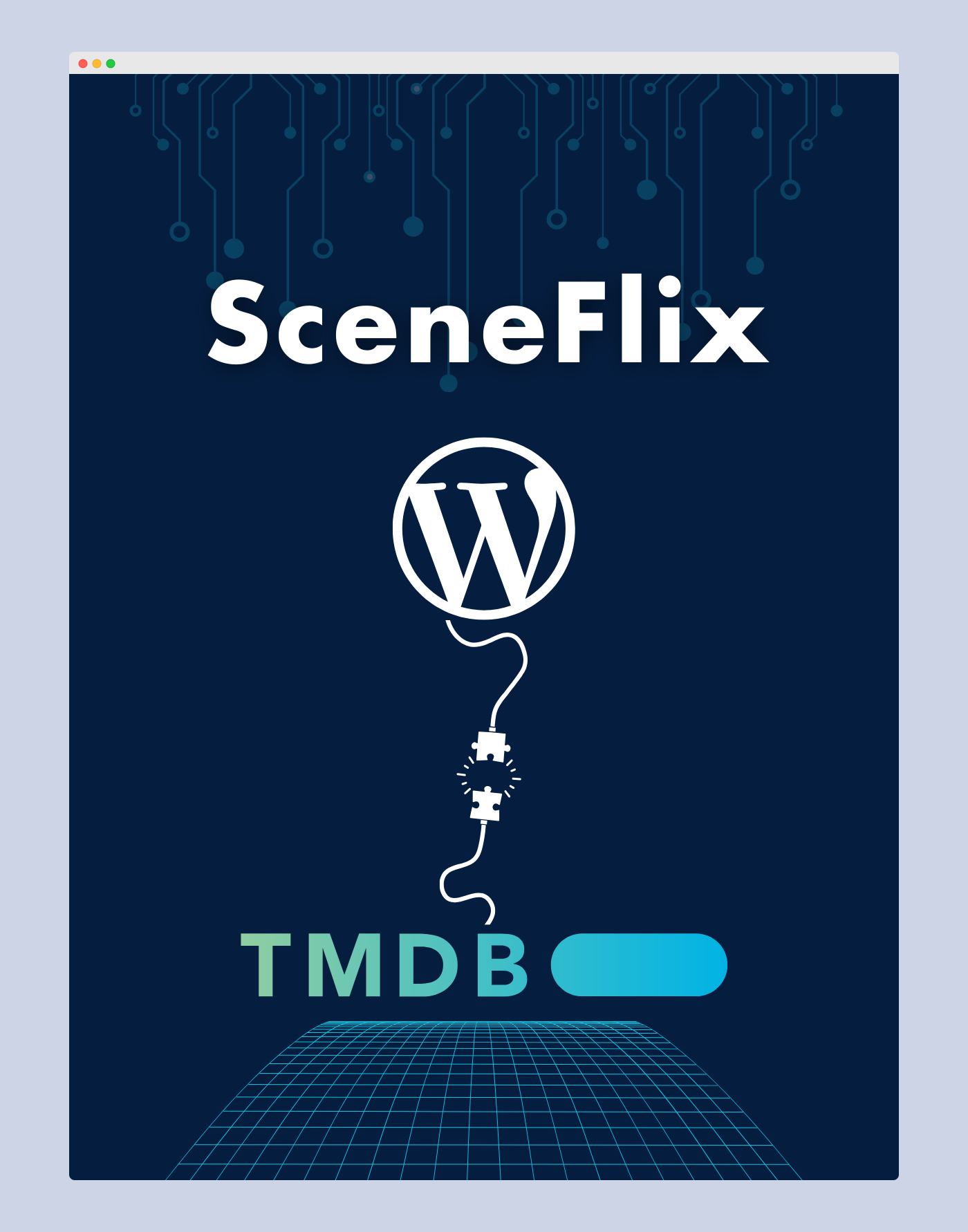
SceneFlix WordPress Bundle
View DetailsSceneFlix WordPress Bundle transforms your WordPress website into a professional movie and TV streaming platform. This powerful combination of SceneFlix Core plugin and theme integrates seamlessly with TMDB API to automatically fetch and organize movie/TV data. Features include automated content import, multi-server streaming support, advanced advertisement management, responsive design, and monetization tools. Perfect for creating streaming sites with minimal effort.
Purchase NowWhat Sets SceneFlix Apart from Other WordPress Movie Themes and Plugins

While most WordPress movie themes and plugins offer basic content display functionality, SceneFlix distinguishes itself through its automated TMDB API integration engine that eliminates manual content entry entirely.
Unlike traditional WordPress movie themes requiring extensive manual database population, SceneFlix implements intelligent automation protocols that fetch, process, and organize content seamlessly.
Core differentiators that revolutionize streaming platform development:
- Automated Content Synchronization – Real-time TMDB data fetching eliminates thousands of hours of manual content entry
- Multi-Server Streaming Architecture – Dynamic parameter replacement system supports unlimited streaming sources with intelligent fallback mechanisms
- Advanced Advertisement Management – Strategic placements to maximize revenue through multiple ad placement locations
- Professional Database Optimization – Custom table structures and caching systems deliver enterprise-level performance scalability
SceneFlix Core Plugin: The Engine Behind Your Streaming Platform
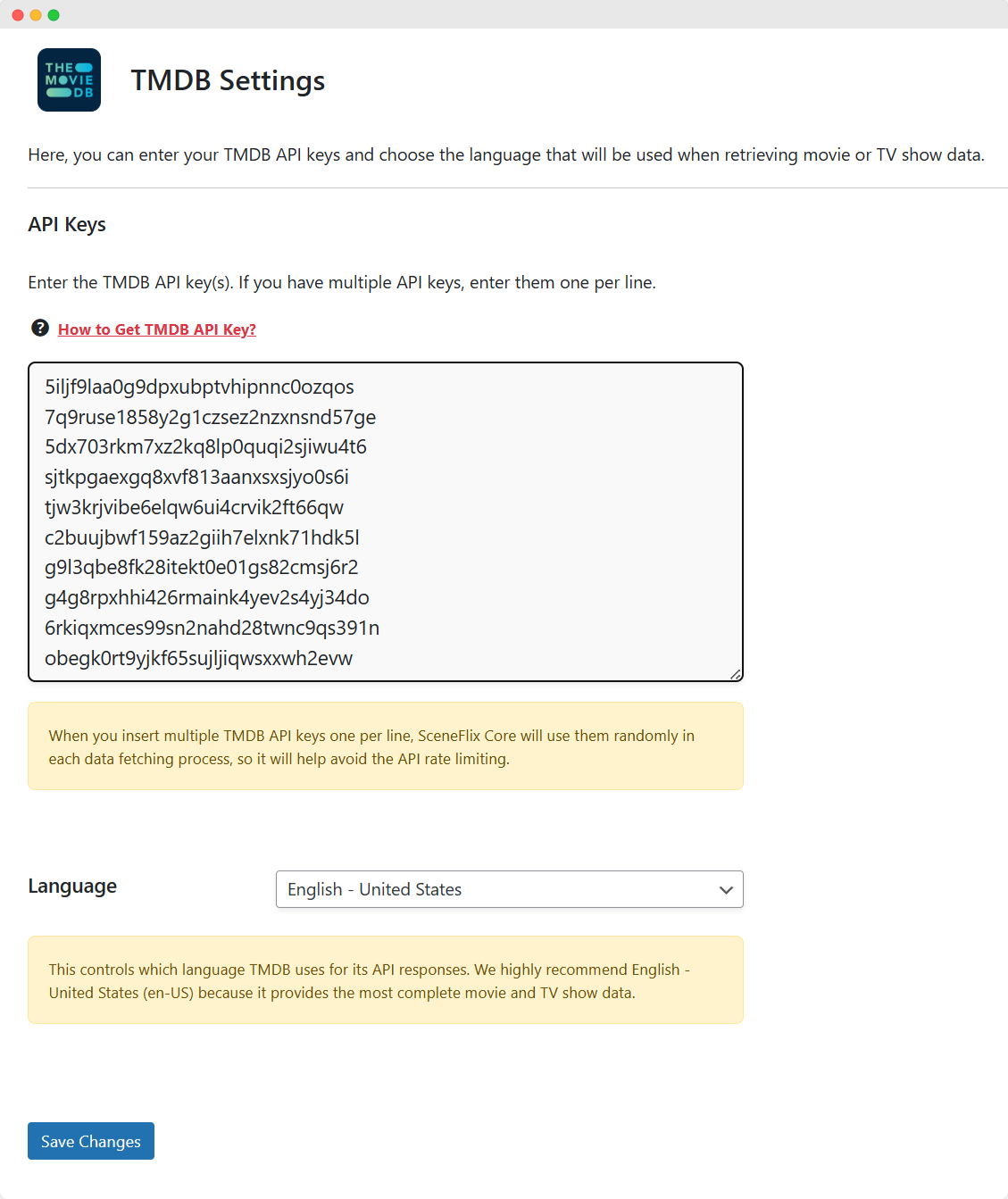
The SceneFlix Core Plugin functions as the central engine that transforms WordPress into a streaming platform through direct TMDB API integration. It automatically fetches and synchronizes movie and TV show data into WordPress custom post types.
The plugin implements specialized movie and tv post types with corresponding taxonomies for genres, cast, and crew. This enables systematic content organization without manual data entry.
Advanced metadata handling mechanisms process TMDB responses, extract relevant fields, and populate WordPress custom fields.
They also maintain data integrity through automated validation and duplicate prevention algorithms.
For understanding more about SceneFlix and how it’s used, please refer to the official SceneFlix Documentation below:
SceneFlix Documentation
It’s super easy to get started with SceneFlix! Table of Contents Understanding the Power of ... Read More
Automated TMDB Integration and Content Synchronization Features
When developers implement the SceneFlix Core Plugin’s automated TMDB integration system, they gain access to a sophisticated content synchronization engine that eliminates manual data entry through intelligent API orchestration.
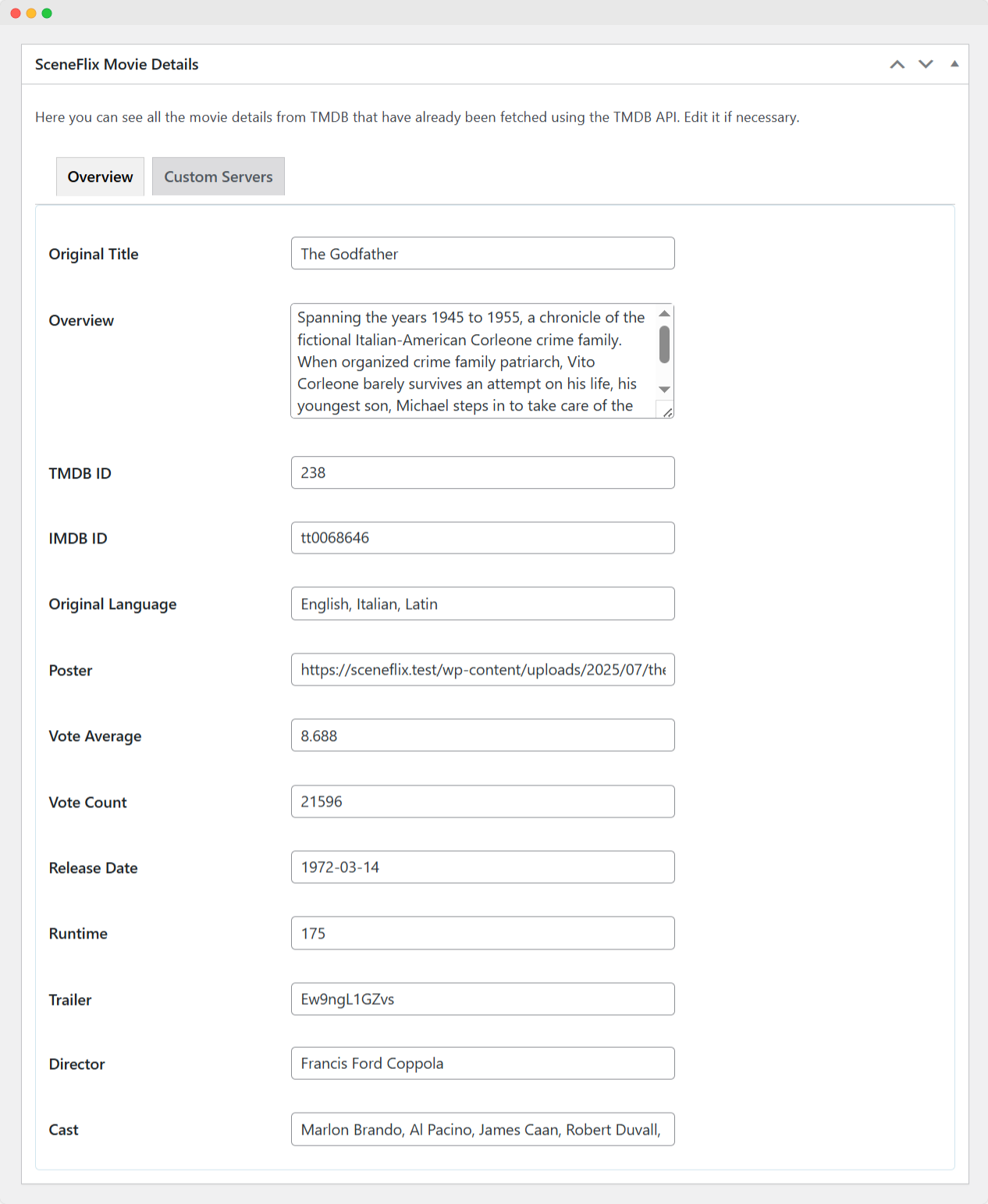
This automated content synchronization framework leverages advanced TMDB API integration protocols to maintain real-time database consistency across extensive movie catalogs.
- Zero-Touch Content Pipeline – Automatically imports 800,000+ movies without manual intervention
- Real-Time Metadata Sync – Instantly updates cast, ratings, and plot information
- Intelligent Duplicate Prevention – Eliminates redundant entries through advanced algorithms
- Multi-Language Content Support – Seamlessly handles 50+ international language variants
Custom Post Types for Movies and TV Series Management
Beyond standard WordPress content structures, SceneFlix Core Plugin implements specialized custom post types that fundamentally restructure content architecture to accommodate the complex hierarchical relationships inherent in streaming media catalogs.
These custom post types enable sophisticated content management through dedicated movie and TV series entities, each containing specialized metadata fields, taxonomies, and relational structures that optimize database queries while maintaining WordPress native functionality.
Advanced Metadata Handling and Content Organization Tools
Although traditional WordPress metadata management relies on basic custom fields and taxonomies, SceneFlix Core Plugin implements a sophisticated multi-layered metadata architecture that automatically processes, validates, and organizes complex entertainment industry data structures from TMDB API responses.
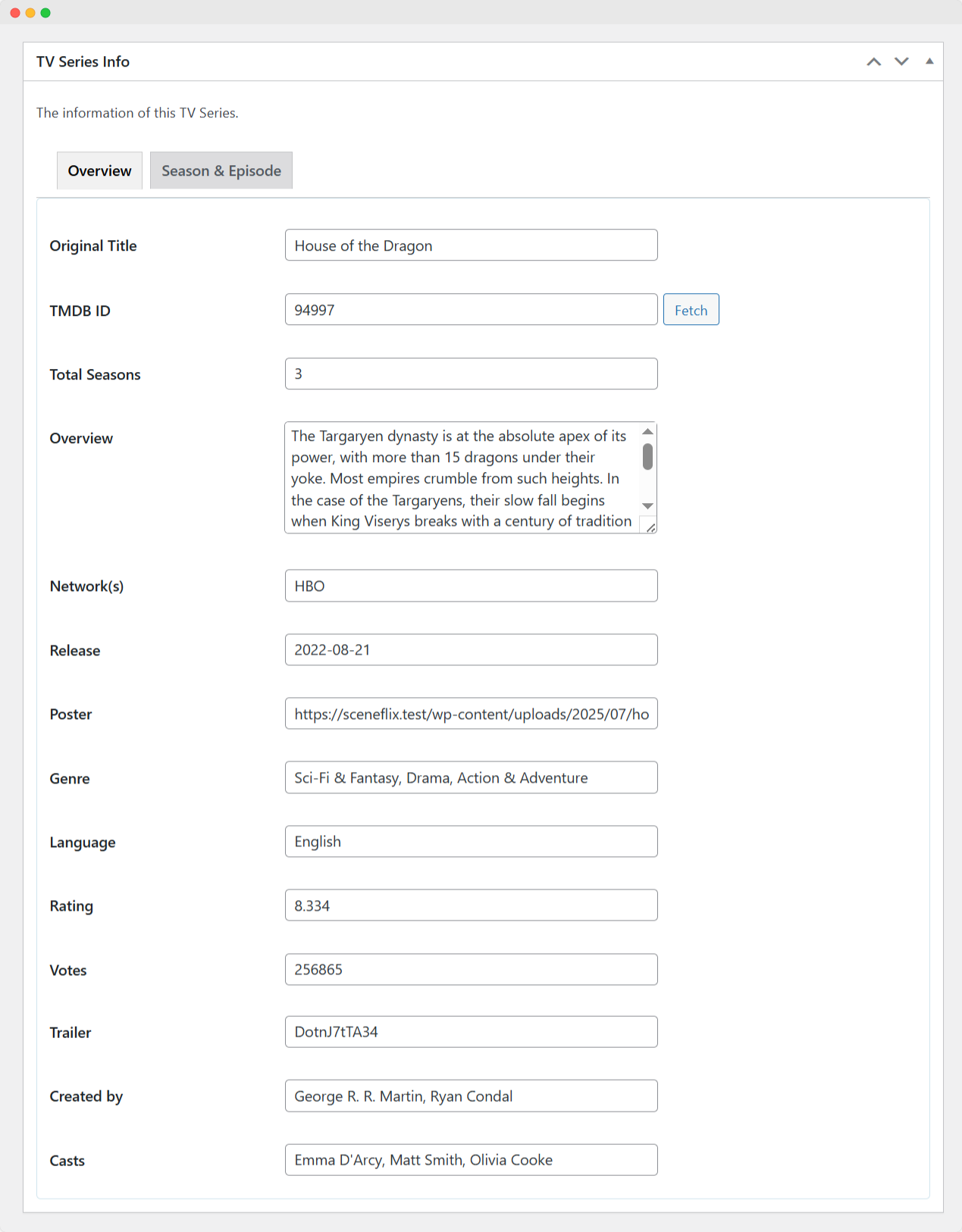
- Intelligent taxonomy generation – Creates hierarchical categories for genres, production companies, and cast members.
- Dynamic field mapping – Converts TMDB JSON responses into structured WordPress metadata.
- Automated content relationships – Links actors, directors, and franchises across multiple titles.
- Real-time synchronization protocols – Maintains data integrity between TMDB updates and local storage.
SceneFlix Theme: Creating a Professional Netflix-Like User Experience

The SceneFlix WordPress theme transforms raw TMDB data into a polished streaming interface through responsive CSS grid layouts and JavaScript-powered carousels that adapt seamlessly across desktop, tablet, and mobile viewports.
Homepage customization operates through SceneFlix custom theme options integration, enabling dynamic widget positioning, content block arrangements, and template hierarchy modifications without requiring code changes.
The theme implements AJAX-driven search functionality with real-time filtering parameters, taxonomical sorting mechanisms, and faceted navigation systems that process user queries against movie metadata stored in custom post types and taxonomies.
Modern Responsive Design That Works on All Devices
Why does responsive design matter more for streaming platforms than traditional websites?
SceneFlix’s responsive design architecture guarantees seamless mobile compatibility across all viewport dimensions.
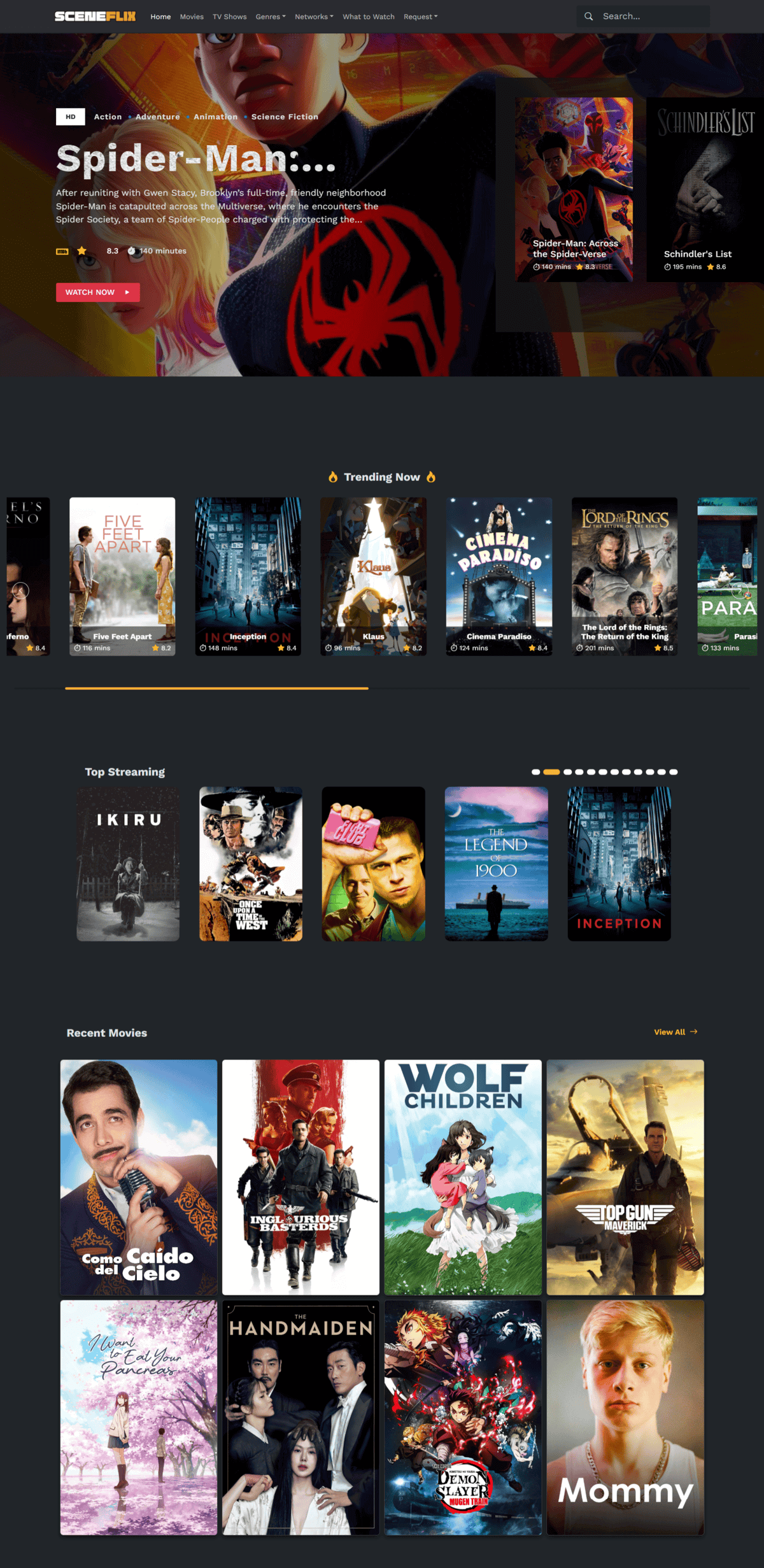
The theme implements CSS Grid and Flexbox methodologies for fluid content adaptation, delivering consistent streaming experiences regardless of device specifications.
- Adaptive viewport scaling – Content automatically adjusts from 320px mobile screens to 4K displays
- Touch-optimized navigation – Gesture-based controls enhance mobile streaming engagement
- Progressive image loading – Smart compression maintains visual quality across bandwidth limitations
- Cross-browser compatibility – Consistent functionality across Safari, Chrome, Firefox, and Edge platforms
Customizable Homepage Layouts and Content Display Options
When developers implement SceneFlix’s homepage architecture, they gain access to a sophisticated layout management system that transforms WordPress into a professional streaming platform through modular content blocks and dynamic widget positioning.
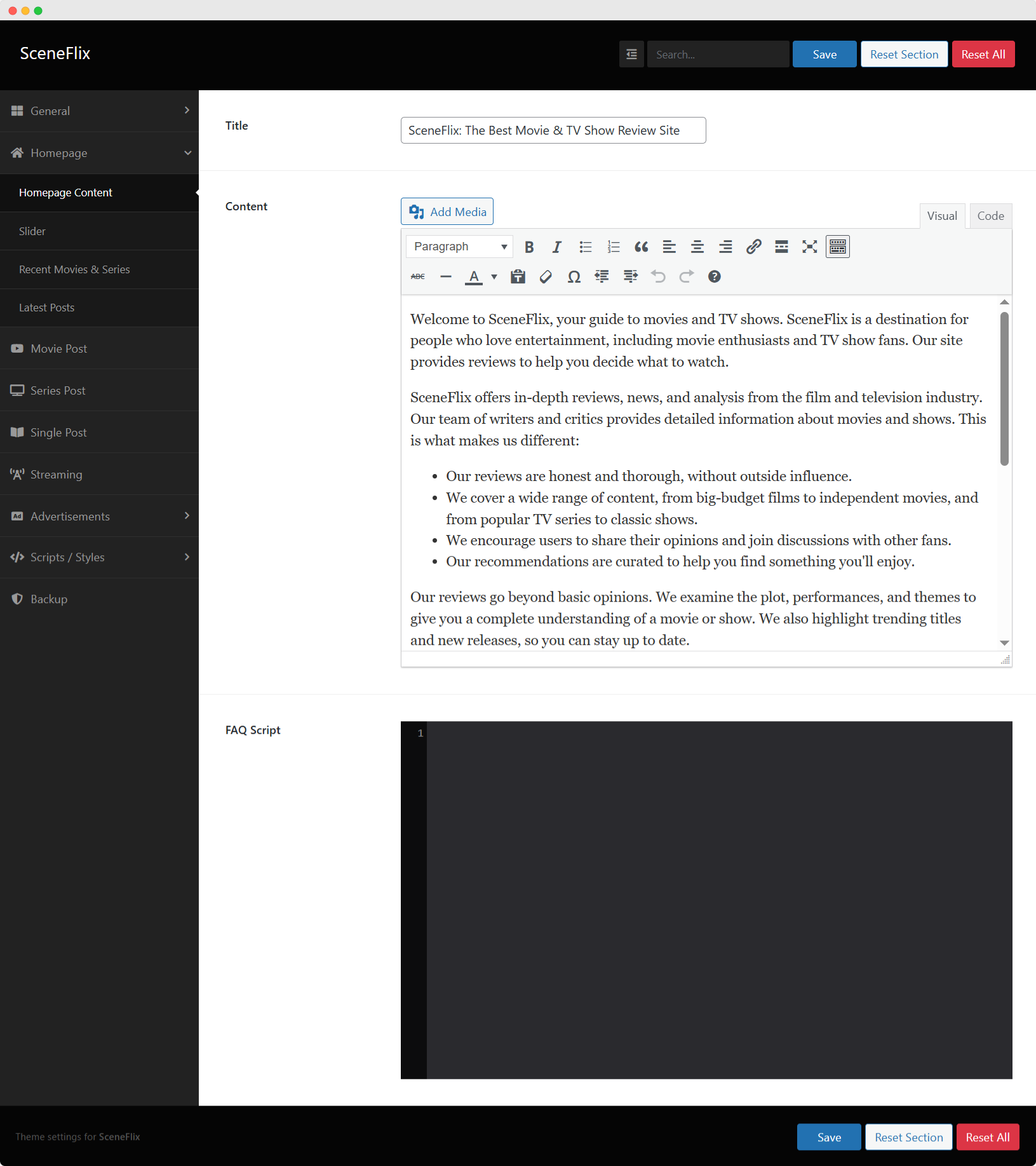
The theme provides flexible homepage layouts featuring carousel sliders, grid arrangements, and featured content sections.
Advanced content display options enable strategic placement of movies, series, and promotional materials across customizable zones.
Advanced Search and Filtering Capabilities for Better User Experience
Advanced search functionality becomes the cornerstone of user engagement when SceneFlix implements its multi-layered filtering architecture through AJAX-powered search interfaces and taxonomical query optimization.
The system processes real-time queries across TMDB metadata, delivering instantaneous results through optimized database indexing and smart caching mechanisms for enhanced performance.
- Dynamic Genre Filtering – Real-time taxonomy queries with zero page refresh
- Smart Autocomplete – Predictive search suggestions powered by TMDB data
- Advanced Parameter Sorting – Multi-criteria filtering by year, rating, language
- Instant Results Display – AJAX-driven content loading with infinite scroll
Installing and Configuring SceneFlix for Maximum Performance
Successful deployment of the SceneFlix WordPress Bundle requires systematic preparation of the hosting environment, proper configuration of API credentials, and strategic theme customization to guarantee peak performance and user experience.
The installation process encompasses three critical phases:
- Establishing WordPress compatibility requirements and security protocols.
- Implementing the SceneFlix Core plugin with TMDB API authentication and database optimization.
- Configuring the theme’s visual elements and customization options.
Each configuration step directly impacts the platform’s functionality, from automated content synchronization to streaming server integration and responsive design implementation.
More detailed guide can be found on:
Installation & Activation
Here’s a straightforward step-by-step guide on how to install and activate the SceneFlix Core ... Read More
Preparing Your WordPress Installation for the SceneFlix Bundle
Before deploying the SceneFlix WordPress Bundle, administrators must implement specific server-level configurations and WordPress enhancements to handle the intensive database operations and media streaming requirements.
The installation process requires configuring PHP memory limits, execution timeouts, and MySQL query optimization settings to support bulk TMDB API data imports and concurrent user streaming sessions.
Essential dependencies include enabling cURL extensions for API connectivity, installing object caching solutions, and configuring CDN integration plugins to guarantee peak performance under high traffic loads.
WordPress Configuration Optimizations for Media Streaming
When implementing a SceneFlix streaming platform, the underlying WordPress configuration requires specific optimizations to handle the intensive database operations, API calls, and media delivery demands that distinguish streaming sites from standard content websites.
- Increase PHP memory limits to 512MB – Handle massive TMDB API responses and complex media metadata processing.
- Configure database query caching – Accelerate content delivery for thousands of movies and TV episodes.
- Enable object caching mechanisms – Reduce server load during peak streaming traffic periods.
- Optimize maximum execution timeframes – Support bulk content imports and extensive WordPress optimization operations.
Database Setup and Performance Tuning Recommendations
The SceneFlix WordPress Bundle’s performance hinges critically on database optimization configurations that extend far beyond standard WordPress installations.
Implementing advanced caching strategies requires MySQL query optimization, indexing custom SceneFlix tables, and configuring Redis or Memcached for TMDB API responses.
InnoDB engine settings, buffer pool allocation, and connection pooling maximize concurrent streaming requests while minimizing database latency for seamless content delivery.
Installing Required Dependencies and Third-Party Plugins
While WordPress core functionality provides the foundation for content management, SceneFlix Bundle deployment requires strategic installation of performance-critical plugins and dependencies that optimize API communication, caching mechanisms, and streaming capabilities.
- WP Rocket – Essential caching plugin that accelerates TMDB API response times and reduces server load during high-traffic streaming sessions.
- Redis Object Cache – Memory-based caching system that dramatically improves database query performance for movie metadata retrieval.
- Query Monitor – Development tool for identifying performance bottlenecks in WordPress plugins during SceneFlix integration testing.
- WP Crontrol – Scheduled task manager enabling automated TMDB API synchronization processes.
Setting Up the SceneFlix Core Plugin for TMDB Integration
The SceneFlix Core plugin requires proper TMDB API key configuration to establish automated content synchronization between The Movie Database and your WordPress installation.
Language settings must be configured to define content localization parameters, regional availability filters, and multi-language metadata fetching preferences that determine which TMDB content variants populate your streaming platform.
Automated import schedules utilize WordPress cron jobs to execute batch content retrieval operations, ensuring your movie and TV show database remains current without manual intervention.
Configuring Your TMDB API Keys for Automated Content Fetching
Before any automated content fetching can commence, developers must obtain and properly configure TMDB API credentials within the SceneFlix Core plugin architecture.
The TMDB API integration requires precise configuration to enable seamless data synchronization and real-time content updates across the streaming platform infrastructure.
- Generate API credentials from TMDB developer portal with read permissions
- Configure authentication tokens within SceneFlix plugin settings panel
- Validate connection integrity through automated diagnostic testing protocols
- Enable automated content fetching for continuous database synchronization
Understanding Language Settings and Multi-Regional Content Support
How effectively can developers leverage SceneFlix’s extensive language configuration system to deliver localized streaming experiences across diverse global markets?
The plugin supports 50+ languages through TMDB integration, enabling automatic metadata fetching in target locales. Developers configure language parameters via admin panel, implementing ISO language codes for regional content delivery.
Multi-language taxonomy creation ensures thorough localization across genres, cast information, and plot descriptions for global audiences.
Setting Up Automated Content Import Schedules
Building upon extensive language configuration capabilities, automated content import schedules represent the cornerstone of maintaining fresh, dynamic movie and TV show libraries without manual intervention.

SceneFlix leverages WordPress cron functionality to orchestrate systematic TMDB API calls, ensuring content repositories remain current with minimal server overhead.
- Real-time synchronization – Your audience experiences cutting-edge content the moment it becomes available
- Zero-maintenance operation – Content flows seamlessly while you focus on growing your platform
- Intelligent resource management – Smart scheduling prevents API rate limits and server overload
- Scalable growth architecture – Import thousands of titles systematically without performance degradation
Customizing the SceneFlix Theme to Match Your Brand
The SceneFlix theme provides extensive branding customization through its advanced theme options panel, enabling administrators to upload custom logos and configure brand-specific visual elements that replace default styling.
Color scheme modifications and typography selections are managed through dedicated configuration sections that allow real-time preview of changes across all theme components including headers, content areas, and navigation elements.
Homepage layout configuration requires careful attention to widget placement and featured content carousel settings, which directly impact user engagement and content discovery patterns through strategic positioning of TMDB-sourced movie data.
Logo Upload and Branding Configuration Options
Establishing visual brand identity within SceneFlix requires systematic configuration of logo assets and branding elements through the theme’s all-encompassing customization interface.
Advanced logo branding controls enable precise positioning, scaling, and optimization across multiple viewport configurations.
- Upload high-resolution SVG logos for crisp display across all device resolutions
- Configure dynamic favicon generation from primary brand assets automatically
- Implement responsive logo sizing with breakpoint-specific dimension controls
- Establish consistent brand color schemes throughout the streaming interface
Color Schemes and Typography Customization
Beyond logo implementation, all-encompassing visual identity requires systematic configuration of color palettes and typographic hierarchies that extend brand consistency throughout every interface element.
SceneFlix provides granular control over color schemes through hexadecimal value inputs, enabling precise brand matching across navigation, buttons, and content areas.
Typography customization encompasses font family selection, weight configurations, and responsive scaling parameters for suitable cross-device readability.
Homepage Layout Configuration and Featured Content Setup
Homepage architecture serves as the foundational interface layer where visitors form initial impressions and navigate content discovery pathways.
SceneFlix homepage layout configuration enables precise control over featured content presentation through modular component arrangements and dynamic content zones.
- Hero slider configuration – Configurable carousel displays for premium content showcasing
- Content grid arrangements – Responsive layout systems with customizable column distributions
- Featured content algorithms – Automated highlighting based on popularity metrics and ratings
- Interactive navigation elements – Dynamic filtering controls and genre-based content discovery
Building Your Content Library with Automated TMDB Integration
The SceneFlix core plugin establishes automated workflows that utilize the TMDB API to fetch thorough movie and television metadata, including cast information, plot summaries, and high-resolution imagery.
It then processes this data into WordPress custom post types through intelligent batch operations.
Content administrators can configure bulk import parameters to process thousands of titles simultaneously while maintaining database integrity through built-in validation mechanisms and duplicate prevention algorithms.
The system provides granular control options that allow manual metadata override, custom streaming link assignment, and content quality verification to guarantee ideal user experience and data accuracy.
Understanding How SceneFlix Fetches and Organizes Movie Data
When SceneFlix initializes its TMDB integration, the plugin establishes a sophisticated data pipeline that transforms raw API responses into structured WordPress content through a series of automated processes.
The TMDB API integration leverages intelligent batch processing to systematically retrieve movie metadata, poster imagery, and classification data.
SceneFlix Movie Grabber
SceneFlix Core is powered with a feature called Movie Grabber, which can be used to instantly retrieve a movie data directly from TMDB and using only a single click, create a movie post based on the retrieved information.
SceneFlix TV Show Grabber
Asides from grabbing movie data instantly via the TMDB API, SceneFlix is also equipped with TV Show Grabber feature, which serves the similarity but with additions i.e. fetching and organizing the Seasons and Episodes data then store them into the TV Show post’s metadata.
Content Organization occurs through automated taxonomy creation, where the system dynamically generates WordPress categories for genres, languages, cast members, and production companies.
Each API response undergoes validation protocols that sanitize data fields, optimize image assets, and establish relational mappings between content elements. The transformation pipeline includes:
- Real-time metadata synchronization that updates content automatically without manual intervention
- Intelligent duplicate detection preventing content conflicts and database bloat
- Dynamic schema mapping that translates TMDB fields into WordPress custom fields
- Automated relationship building connecting actors, directors, and franchises seamlessly
Setting Up Bulk Movie Import from TMDB Database
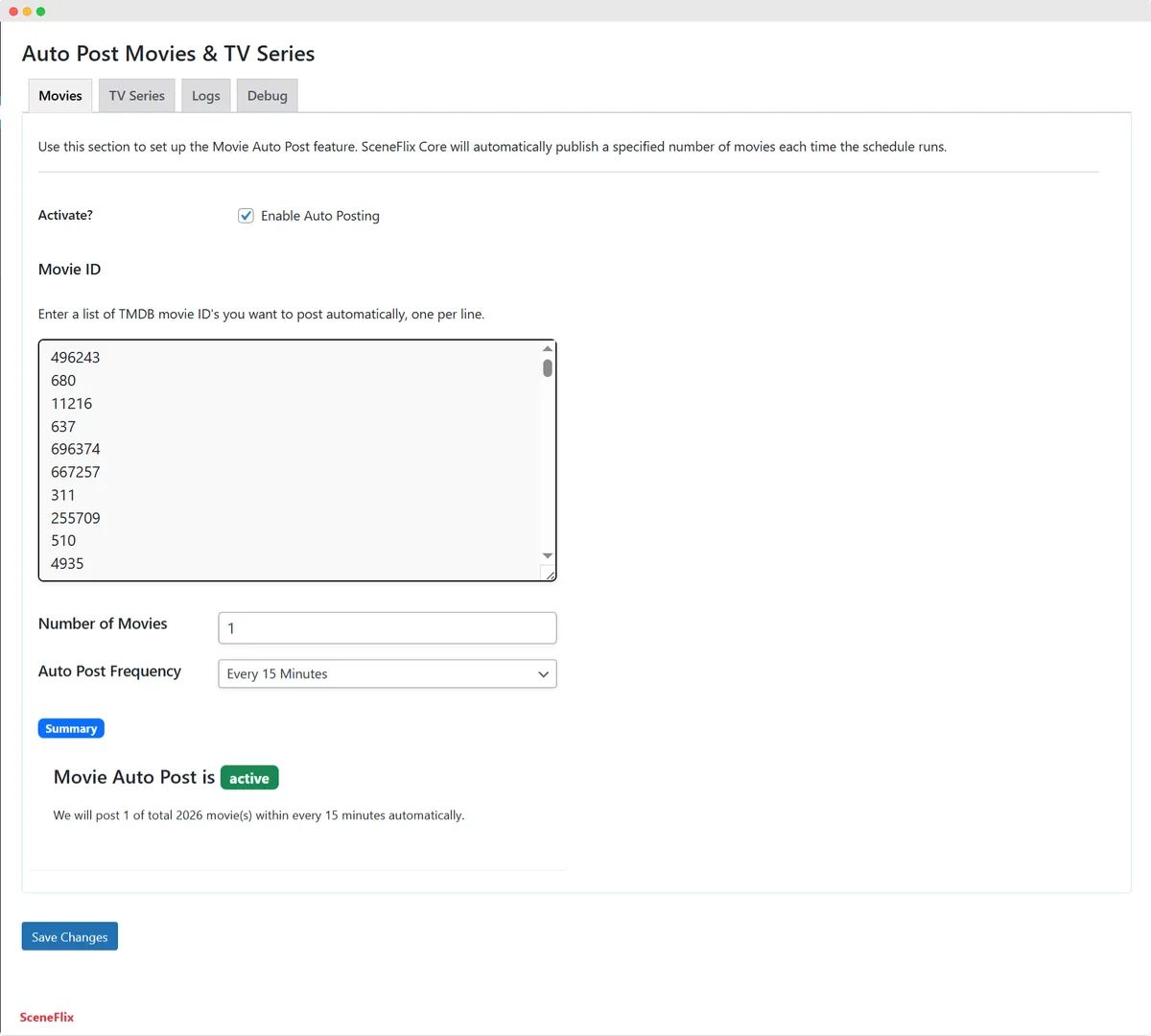
Building a thorough movie library requires strategic content selection and automated data management through SceneFlix’s TMDB integration system.
The bulk import process begins with configuring API endpoints to fetch popular movies, trending content, and genre-specific collections. At the same time, it involves downloading and optimizing associated promotional imagery.
When you purchase SceneFliw WordPress Bundle, you will get free 80,000+ TMDB movie IDs and 11,000+ TMDB TV show IDs. They will be enough to get you started using the Movie and TV Show Auto Post feature.
Proper implementation involves setting up automated workflows that handle metadata extraction, taxonomy assignment, and media file processing to guarantee consistent content organization across the streaming platform.
Selecting Popular Movies and Trending Content for Initial Import
How does one strategically curate an initial content library that maximizes user engagement while establishing credibility for a new streaming platform?
SceneFlix enables targeted selection through TMDB’s popularity algorithms, allowing developers to automatically populate their database with high-engagement content that drives user retention.
- Blockbuster Collection: Import top 1000 highest-grossing films spanning multiple decades
- Trending Algorithm Integration: Leverage TMDB’s real-time trending data feeds
- Genre-Balanced Distribution: guarantee thorough coverage across action, drama, comedy categories
- Award-Winning Showcase: prioritize Oscar, Golden Globe, and Cannes Film Festival winners
Managing Genre Classifications and Content Categories
The SceneFlix WordPress Bundle implements TMDB’s exhaustive taxonomy system through automated genre classification algorithms that dynamically create and populate content categories during the bulk import process.
The system establishes hierarchical genre classifications while generating custom taxonomies for actors, directors, and production companies.
Advanced filtering mechanisms enable precise content categories organization, ensuring seamless navigation across multi-dimensional classification structures for enhanced user discovery experiences.
Handling Movie Posters, Backdrops, and Promotional Images
SceneFlix’s sophisticated image management system automates the download, processing, and enhancement of high-resolution movie posters, backdrop images, and promotional artwork directly from TMDB’s extensive media repository.
- Automated Quality Scaling – Intelligent resolution detection ensures peak image dimensions for different display contexts.
- Progressive Loading Implementation – Lazy-loading mechanisms reduce initial page load times while maintaining visual appeal.
- CDN-Ready Optimization – Compressed formats maintain visual fidelity while minimizing bandwidth consumption.
- Fallback Management – Smart placeholder systems handle missing promotional images gracefully.
Managing TV Series and Episode Content Effectively
The SceneFlix WordPress Bundle implements a sophisticated hierarchical content management system that automatically organizes TV series into seasons and episodes through custom post type relationships and taxonomies.
The system leverages TMDB API’s series endpoints to fetch episode metadata, air dates, and season structures while implementing automated cron jobs for real-time content synchronization and new release notifications.
Proper navigation implementation requires configuring custom query parameters, episode tracking mechanisms, and sequential playback functionality to create seamless binge-watching experiences with next-episode automation and progress indicators.
Season and Episode Organization Systems
Managing television series content requires sophisticated organizational frameworks that can handle multi-layered hierarchical relationships between shows, seasons, and individual episodes.
SceneFlix implements advanced season management and episode organization through automated TMDB integration, creating structured content hierarchies that enable seamless navigation and content discovery.
- Automated season detection – Creates hierarchical database structures with parent-child relationships
- Episode metadata synchronization – Pulls air dates, descriptions, and runtime data automatically
- Sequential navigation systems – Enables binge-watching with next-episode functionality
- Cross-season search capabilities – Indexes content across multiple seasonal boundaries
Automated Episode Updates and New Release Notifications
Beyond the foundational organization of seasonal content structures, SceneFlix implements real-time synchronization mechanisms that monitor TMDB endpoints for newly released episodes and series updates.
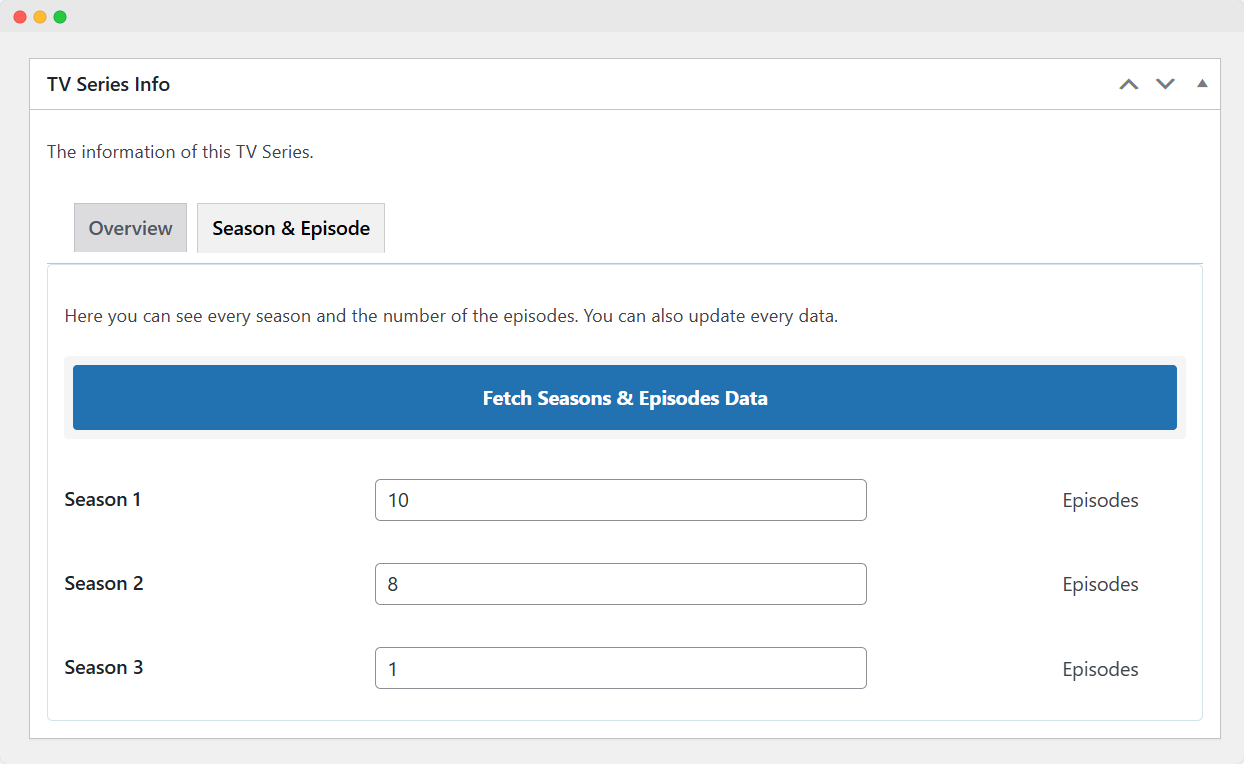
The system executes scheduled cron jobs that poll API endpoints, triggering automated content updates when new episodes become available. Webhook integration enables instant new release notifications, ensuring content libraries remain current without manual intervention.
Creating Binge-Watching Experiences with Proper Navigation
How does SceneFlix transform standard episode navigation into an immersive binge-watching experience that keeps viewers engaged across multiple episodes?
The system implements advanced binge-watching navigation through automated season/episode progression, intelligent next-episode queuing, and seamless content handovers that eliminate viewing friction.
- Automated Next-Episode Countdown – Implements 10-second countdown timers with skip options for uninterrupted viewing sessions.
- Smart Episode Queuing – Preloads subsequent episodes while current content plays for instant transitions.
- Season Boundary Detection – Automatically bridges season gaps with preview trailers and recap content.
- Progress State Persistence – Maintains viewing position across devices using localStorage and database synchronization.
Content Quality Control and Manual Override Options
While SceneFlix automates content import through TMDB API integration, administrators retain full editorial control over imported movie and TV series data through WordPress’s native post editing interface.
The system preserves automatic synchronization while allowing manual modifications to descriptions, metadata fields, and custom taxonomies without triggering API overwrites during subsequent update cycles.
Content quality management extends to editorial review workflows, custom rating systems, and age classification assignments that supplement or override TMDB-provided content ratings based on regional broadcasting standards.
Reviewing and Editing Automatically Imported Content
Although SceneFlix’s automated TMDB integration efficiently populates content libraries with thousands of movies and TV shows, the system provides thorough manual override capabilities to guarantee content quality and accuracy.
The automated content management system ensures seamless metadata synchronization while preserving editorial control.
- Real-time Content Validation – Monitor imported data accuracy and flag inconsistencies instantly
- Custom Metadata Override – Replace API-sourced information with manually curated content details
- Streaming Link Management – Configure custom video sources beyond automated server assignments
- Featured Content Curation – Manually promote high-quality titles regardless of algorithmic suggestions
Adding Custom Descriptions and Editorial Reviews
Why settle for generic TMDB descriptions when SceneFlix enables all-encompassing editorial control through its custom content override system? The platform’s custom descriptions module allows complete replacement of automated content with hand-crafted narratives.
Editorial reviews integrate seamlessly into the existing database structure, overriding TMDB data while maintaining API synchronization for metadata updates and technical specifications.
Managing Content Ratings and Age Classifications
The SceneFlix content rating system automatically imports MPAA classifications, international age ratings, and content advisories directly from TMDB API endpoints, then processes this data through a sophisticated filtering engine that categorizes content by audience appropriateness levels.
- Automated G-PG-13-R classification parsing guarantees instant content ratings without manual intervention
- International age classifications support global audiences with localized rating standards
- Content advisory filtering protects younger viewers through intelligent categorization algorithms
- Custom rating overrides provide administrative control for specialized content curation requirements
Configuring Streaming Sources and Video Content Delivery
Video content delivery in SceneFlix requires configuring streaming sources that utilize dynamic parameter replacement with tokens like {tmdb_id}, {season}, and {episode} to construct valid streaming URLs.
The platform supports multiple concurrent streaming servers, enabling administrators to implement redundancy through failover mechanisms and load distribution across different content delivery networks.
Advanced video player configuration encompasses embedding parameters, quality selection controls, and user interface customizations that directly integrate with the WordPress media handling system.
Understanding Different Streaming Source Options and Configurations
When configuring streaming sources within the SceneFlix WordPress Bundle, administrators must understand that the system supports multiple delivery methods through its dynamic parameter replacement engine.
Each streaming server configuration leverages intelligent parameter substitution using tokens like {tmdb_id}, {season}, and {episode} to dynamically construct video URLs.
The streaming source architecture accommodates various content delivery networks and hosting solutions, enabling seamless integration with existing infrastructure.
- Multi-server redundancy – Configure unlimited backup servers to ensure zero downtime and maximum content availability
- Dynamic URL generation – Automatically construct streaming links using TMDB metadata for instant content access
- Custom parameter mapping – Define server-specific variables to match any streaming provider’s URL structure requirements
- Intelligent fallback systems – Automatically redirect users to alternative servers when primary sources become unavailable
Setting Up Multiple Streaming Servers for Redundancy
The SceneFlix WordPress Bundle implements a robust multi-server streaming architecture that enables administrators to configure primary and backup streaming sources through the plugin’s server management interface.
The system utilizes dynamic URL parameters including {tmdb_id}, {season}, and {episode} to construct flexible streaming endpoints that automatically adapt to content type and user requests.
Server configuration supports quality-based routing and user preference handling, allowing the platform to deliver superior streaming experiences while maintaining redundancy through intelligent failover mechanisms.
Configuring Primary and Backup Streaming Sources
Although content availability represents the foundation of any streaming platform, establishing robust streaming source redundancy guarantees uninterrupted video delivery when primary servers experience downtime or geographical restrictions.
SceneFlix enables administrators to configure multiple streaming server endpoints with sophisticated fallback mechanisms, ensuring seamless content delivery across diverse network conditions and geographical locations.
- Primary streaming server configuration with high-bandwidth capabilities for ideal performance
- Secondary backup sources automatically activated during primary server failures
- Geographical load distribution ensuring global audience accessibility regardless of location
- Dynamic failover protocols providing millisecond switching between streaming sources
Using Dynamic URL Parameters for Flexible Content Delivery
Dynamic URL parameters serve as the cornerstone of SceneFlix’s flexible streaming architecture, enabling administrators to establish standardized streaming endpoints that automatically adapt to specific content requirements through intelligent variable substitution.
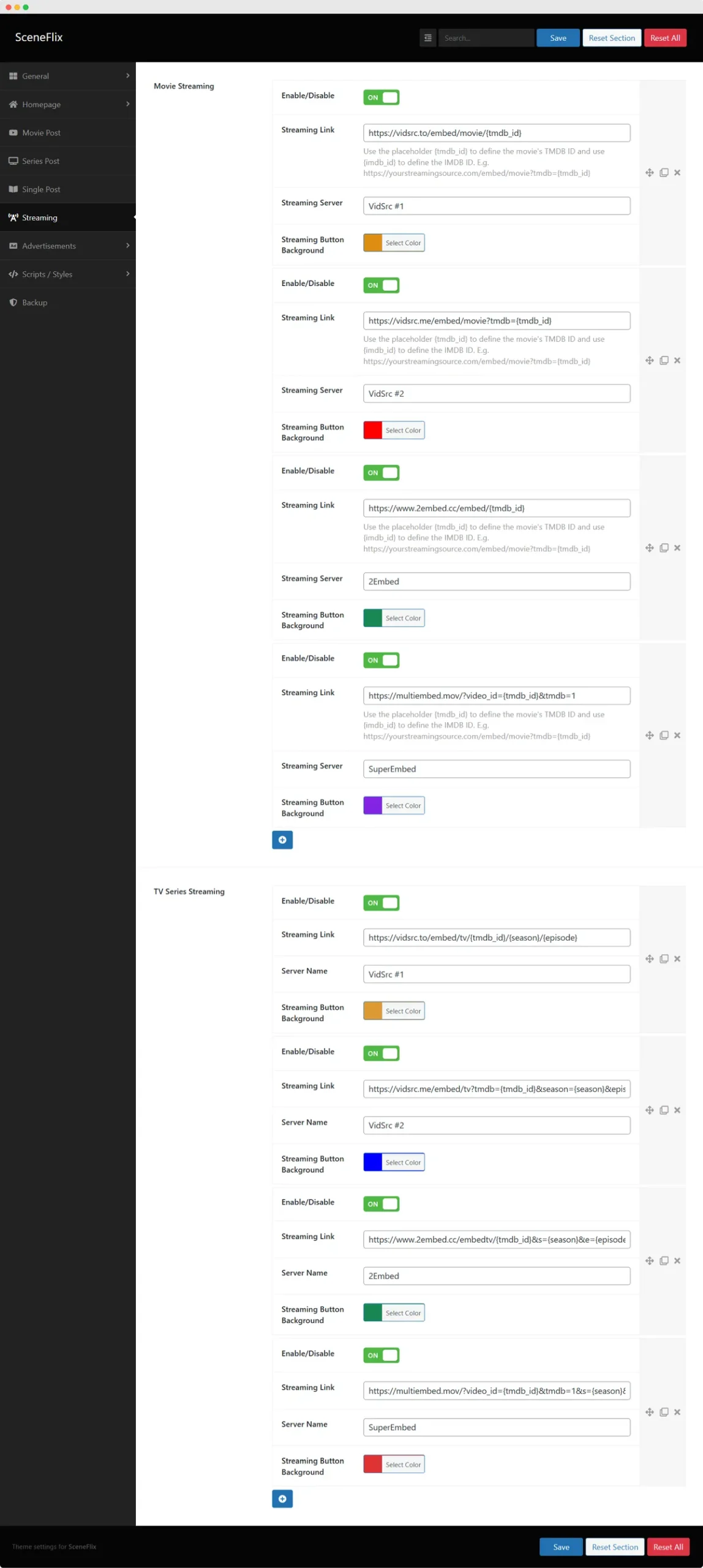
The system implements {tmdb_id}, {season}, and {episode} placeholders within streaming URLs, creating scalable templates that dynamically populate with TMDB API data during content requests, ensuring consistent delivery across diverse streaming sources.
Sample usages are as follows:
- For movie posts, users can use the placeholder {
tmdb_id}to define the movie’s TMDB ID and use{imdb_id}to define the IMDB ID. Sample usage is:https://yourstreamingsource.com/embed/movie?tmdb={tmdb_id} - For TV show posts, users can insert the TV Series Streaming link with
{tmdb_id},{season}, and{episode}parameters. Sample usage is:https://.yourstreamingsource.com/embed/tv/{tmdb_id}/{season}/{episode}
For all the free video streaming API links that currently work with SceneFlix, please refer to the following documentation:
Free Video Streaming API Links
SceneFlix is designed to work with all current video streaming API links available online, making ... Read More
Asides from automatic streaming link generation via the placeholder parameters, users can also manually add up to three streaming links directly on the movie and TV show post editor screen via the SceneFlix metabox as shown below:
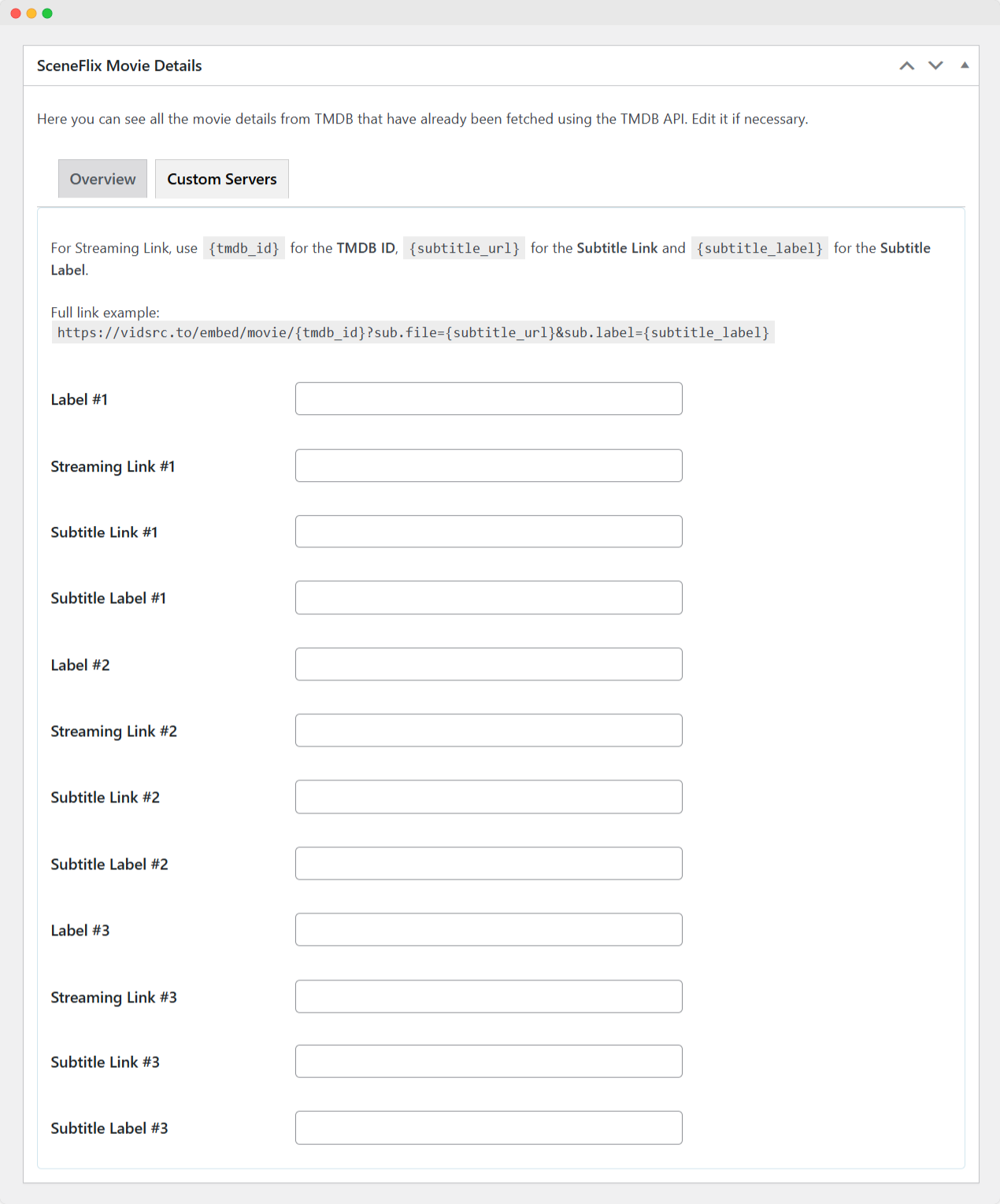
It proves SceneFlix’s flexibilities in all areas to create a movie streaming website, as well as TV show streaming site.
Managing Different Video Quality Options and User Preferences
How effectively can streaming platforms accommodate diverse user preferences and network conditions while maintaining consistent playbook quality?
SceneFlix implements adaptive streaming through configurable quality parameters and user preference storage, enabling personalized viewing experiences across bandwidth constraints.
- Automatic quality detection – Intelligent bandwidth assessment for ideal streaming
- User-controlled resolution selection – Empowering viewers with quality choices
- Preference persistence – Seamless experience across sessions
- Adaptive bitrate streaming – Dynamic quality adjustment
Implementing Video Player Features and User Controls
The SceneFlix video player implementation requires systematic configuration of interface controls, subtitle integration, and navigation systems to create a professional streaming experience.
Customizing player controls involves modifying CSS classes and JavaScript event handlers within the theme’s video player templates.
Subtitle support necessitates proper VTT file handling and language selector implementation.
Series navigation functionality depends on establishing proper episode data relationships through custom post meta fields and implementing AJAX-powered navigation controls that seamlessly shift between episodes without page reloads.
Customizing the Video Player Interface and Controls
Video player customization within the SceneFlix WordPress system requires precise configuration of multiple interface components and control mechanisms to deliver a professional streaming experience.
Advanced video player customization transforms basic streaming functionality into sophisticated entertainment platforms, while strategic streaming website design ensures ideal user engagement and retention.
- Custom control overlays – Implement personalized play/pause buttons, progress bars, and volume controls that match your brand aesthetic.
- Dynamic quality selection – Enable users to seamlessly switch between HD, 4K, and adaptive streaming resolutions for ideal viewing.
- Interactive subtitle management – Integrate multi-language subtitle support with customizable fonts, sizes, and positioning options.
- Smart playback features – Configure auto-play, skip intro functionality, and episode continuation for binge-watching experiences.
Adding Subtitle Support and Multiple Language Options
Because modern streaming audiences expect seamless multilingual experiences, subtitle support within SceneFlix requires systematic configuration of WebVTT file handling, subtitle track management, and dynamic language switching capabilities.
Developers implement multiple language options through HTML5 video track elements, enabling automated subtitle detection and user-controlled language selection.
This enhances accessibility while supporting international content distribution across diverse viewer demographics.
Creating Seamless Episode Navigation for TV Series
Navigation between episodes requires implementing dynamic URL routing and automated content progression within the SceneFlix video player framework.
The system leverages TMDB metadata to construct episode navigation hierarchies, enabling seamless shifts between episodes within tv series collections through programmatic content loading.
- Dynamic episode progression – Automatic next episode detection eliminates viewer friction
- Season-based navigation controls – Intuitive episode selection enhances user engagement
- Progress tracking integration – Resume functionality maintains viewing momentum
- Keyboard shortcut implementation – Power user controls accelerate episode navigation workflows
Monetizing Your Streaming Platform with Advanced Advertisement Features
The SceneFlix WordPress Bundle implements a thorough advertisement management system that enables strategic placement of revenue-generating content across homepage sliders, pre-player zones, and in-content banner positions.
The platform supports multiple ad formats including custom JavaScript implementations, HTML banner codes, and dynamic targeting scripts that can be configured through dedicated admin panels for each placement zone.
Advertisement integration requires careful consideration of user experience metrics, as improper placement can negatively impact content consumption patterns and streaming platform retention rates.
Strategic Advertisement Placement for Maximum Revenue Generation
The SceneFlix WordPress Bundle implements a thorough advertisement management system that strategically positions revenue-generating content across multiple high-visibility zones within the streaming platform interface.
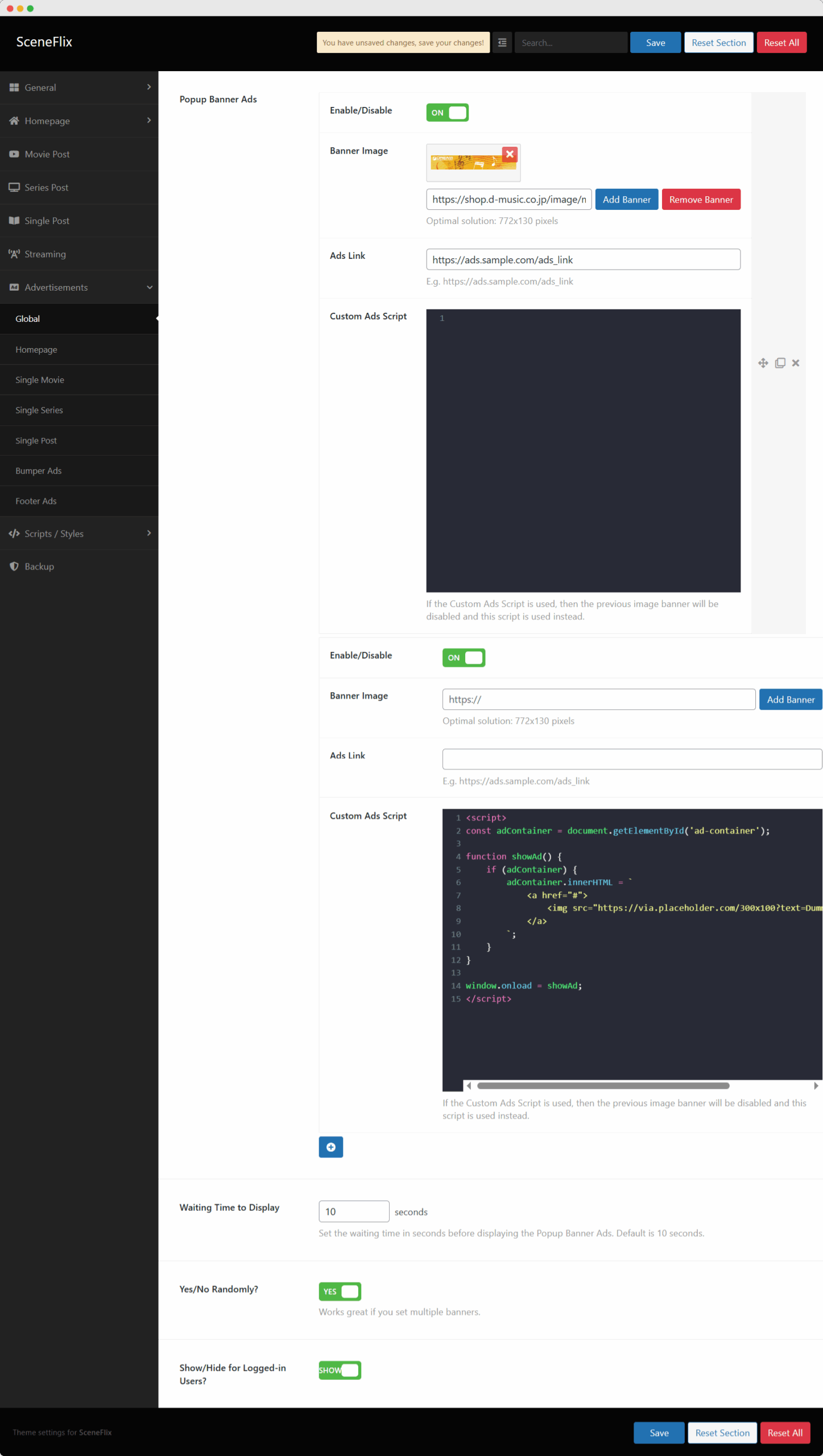
The system provides configurable advertisement placements including homepage banner integration with featured content carousels, pre-roll video advertisements with bumper configuration options that display before streaming content, and dedicated sidebar and footer advertisement zones with dynamic content targeting.
These advertisement implementations utilize WordPress hooks and custom post meta fields to ensure seamless integration with the TMDB API content while maintaining ideal user experience and maximum click-through rates.
Homepage Banner Ads and Featured Content Promotions
How can streaming platform administrators maximize revenue potential while maintaining user engagement through strategic homepage banner advertising?
SceneFlix enables precise homepage banner ads placement with geographic targeting and user role-based display controls.
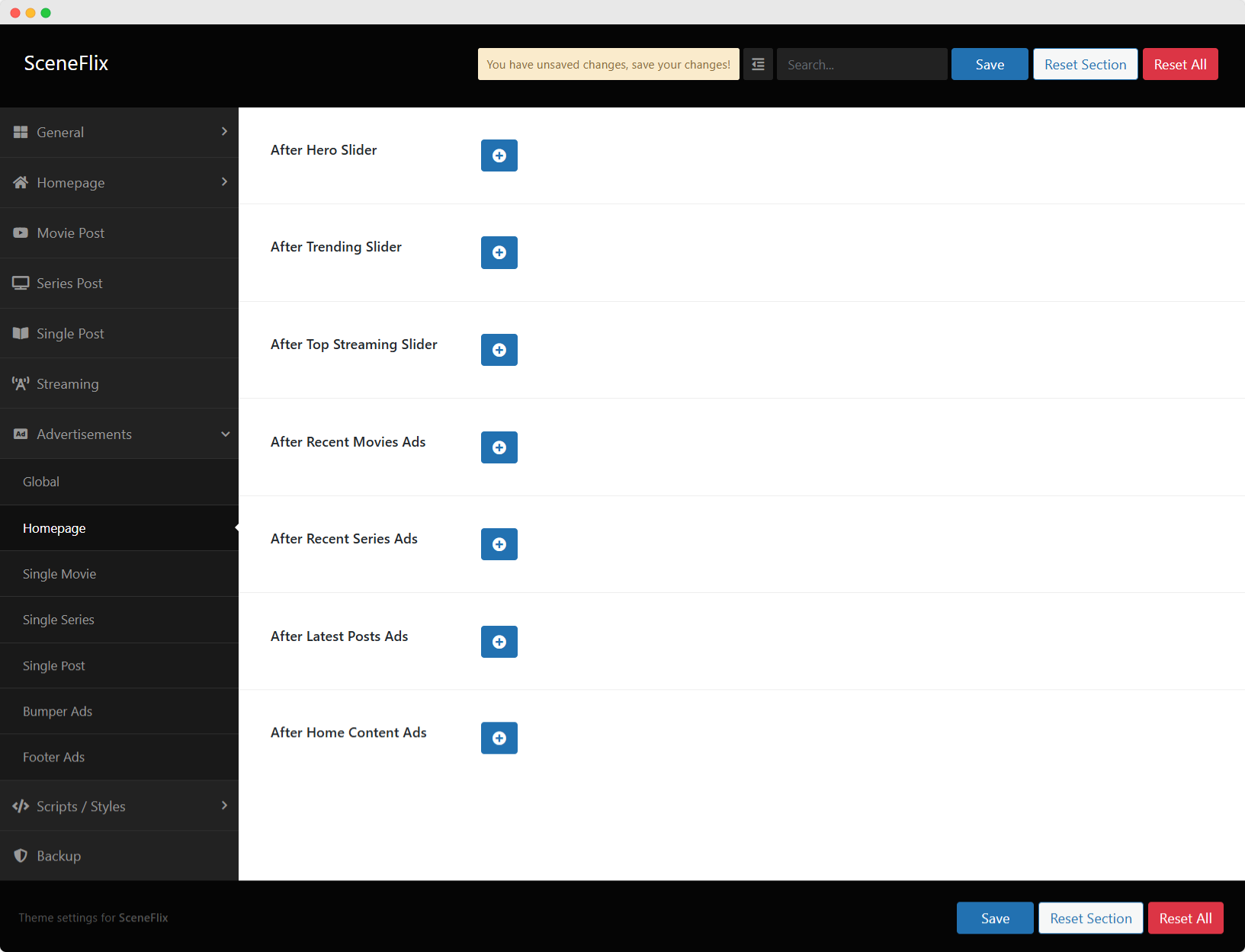
The system supports featured content promotions through automated TMDB integration, ensuring seamless advertisement delivery without compromising user experience.
- Dynamic banner rotation with A/B testing capabilities for conversion optimization
- Native advertising integration that blends seamlessly with movie content layouts
- Revenue tracking dashboard providing real-time click-through rate analytics and performance metrics
- Strategic placement zones including hero sections, carousel breaks, and footer sticky advertisements
Pre-Roll Video Ads and Bumper Advertisement Configuration
Pre-roll video advertisements and bumper configurations represent critical revenue maximization components within SceneFlix’s monetization framework, enabling streaming platform operators to implement sophisticated advertisement delivery systems before primary video content begins.
Advanced pre-roll advertising mechanisms integrate seamlessly with TMDB-sourced content, while customizable bumper ads deliver targeted promotional messages through configurable duration parameters, server-specific branding elements, and automated playback sequences that optimize user engagement and advertiser return-on-investment metrics.
Sidebar and Footer Advertisement Zones
Where traditional streaming platforms rely on interruptive advertisement models, SceneFlix’s sidebar and footer advertisement zones establish persistent revenue channels through strategically positioned display areas that maintain continuous visibility throughout user navigation sessions.
- Dynamic sidebar ads automatically adjust positioning based on content hierarchy and user scroll behavior patterns.
- Sticky footer zones maintain advertisement visibility across all page transitions and navigation events.
- Responsive advertisement containers seamlessly adapt dimensions for ideal display across mobile and desktop viewports.
- Custom CSS targeting enables precise advertisement placement control through advanced selector implementation.
Setting Up Different Ad Types and Custom Advertisement Scripts
SceneFlix provides extensive advertisement integration capabilities through its advanced ad management system that supports multiple advertisement formats and custom script implementation.
The platform enables administrators to configure image banner advertisements with built-in click-through tracking mechanisms, implement custom HTML and JavaScript advertisement code for third-party ad networks, and establish video advertisement rotation systems with pre-roll and mid-roll placement options.
These advertisement types utilize SceneFlix’s native targeting engine and analytics framework to optimize revenue generation while maintaining seamless integration with the streaming platform’s user interface.
Image Banner Advertisements with Click-Through Tracking
While video advertisements generate substantial revenue, image banner advertisements remain the cornerstone of streaming platform monetization due to their non-intrusive nature and superior click-through tracking capabilities.
SceneFlix implements sophisticated advertisement optimization systems that enable precise user engagement analytics and revenue maximization.
- Real-time conversion tracking measures user engagement across multiple banner placements
- Dynamic A/B testing automatically optimizes ad performance for maximum revenue generation
- Seamless user experience maintains viewer satisfaction while driving consistent monetization
- Advanced targeting algorithms deliver personalized advertisements based on viewing preferences
Custom HTML and JavaScript Advertisement Integration
Beyond standard banner placements, streaming platforms require sophisticated advertisement integration capabilities that accommodate complex third-party advertising networks, affiliate marketing scripts, and custom promotional campaigns.
SceneFlix enables developers to implement custom HTML and JavaScript code blocks directly into template positions, supporting dynamic content loading, real-time bidding systems, and advanced tracking pixels for extensive advertisement integration across streaming interfaces.
Video Advertisement Management and Rotation Systems
When implementing video advertisements within streaming platforms, administrators require sophisticated rotation and management systems that handle pre-roll, mid-roll, and post-roll video content with programmatic precision.
SceneFlix’s advanced ad management infrastructure enables dynamic video advertisement scheduling with intelligent rotation algorithms that maximize revenue while maintaining ideal user engagement throughout streaming sessions.
- Real-time ad rotation algorithms that dynamically select highest-performing video advertisements based on user demographics and viewing patterns
- Seamless pre-roll integration that eliminates buffering delays while maintaining professional broadcast-quality advertisement delivery standards
- Intelligent frequency capping that prevents advertisement fatigue by controlling exposure rates across multiple viewing sessions
- Advanced analytics dashboards providing granular performance metrics for optimizing advertisement placement and rotation strategies
User Experience Considerations for Advertisement Placement
Strategic advertisement placement requires careful balance between revenue optimization and user retention metrics, as poorly positioned ads can considerably increase bounce rates and reduce session duration.
Premium subscription tiers that eliminate advertisements provide higher-value users with uninterrupted streaming experiences while maintaining ad-supported access for broader market penetration.
A/B testing frameworks enable systematic evaluation of ad positioning variables, measuring click-through rates, user engagement metrics, and revenue per visitor to optimize placement algorithms.
Balancing Revenue Generation with User Satisfaction
The SceneFlix WordPress Bundle’s advertisement management system provides developers with granular control over ad placement strategies through configurable hooks and template overrides that directly impact both revenue optimization and user retention metrics.
Strategic monetization implementation requires balancing aggressive revenue targets against user experience degradation through intelligent frequency capping and contextual positioning algorithms.
- Progressive Ad Loading – Implement lazy-loaded advertisement containers that activate based on user scroll depth and engagement patterns
- Dynamic Frequency Control – Deploy smart algorithms that adjust ad density based on user session duration and return visitor status
- Content-Aware Positioning – Utilize TMDB metadata to serve contextually relevant advertisements that enhance rather than interrupt viewing flow
- Performance Impact Monitoring – Track real-time metrics showing correlation between ad placement density and user abandonment rates
Creating Premium Ad-Free User Experiences
Premium subscription tiers within the SceneFlix WordPress Bundle architecture require implementing role-based advertisement filtering mechanisms that selectively bypass ad rendering functions through conditional template logic and user capability checks.
Developers configure membership-based monetization strategies where premium subscribers access ad-free streaming environments, enhancing user experience through streamlined content delivery while maintaining revenue streams through tiered subscription models and strategic advertisement exclusion protocols.
A/B Testing Advertisement Positions for Better Performance
Optimizing advertisement performance within SceneFlix WordPress Bundle implementations requires systematic A/B testing methodologies that evaluate multiple ad placement configurations against user engagement metrics and revenue generation data.
Strategic ad optimization demands continuous testing cycles to maximize conversion rates while maintaining ideal user experience standards.
- Revenue Performance Analytics – Track click-through rates and conversion metrics across different ad placement positions
- User Engagement Monitoring – Measure bounce rates and session duration variations between advertisement configurations
- Heat Map Analysis – Visualize user interaction patterns to identify prime ad optimization zones
- Conversion Funnel Optimization – Test advertisement timing sequences for maximum revenue generation impact
Search Engine Optimization and Content Discovery Features
Search engine optimization represents a critical infrastructure component for movie streaming platforms, requiring systematic implementation of schema markup, structured data, and content indexing strategies that maximize TMDB-sourced content visibility.
The SceneFlix system integrates automated SEO protocols through programmatic meta tag generation, semantic URL structures, and JSON-LD schema implementation that transforms raw movie database entries into search engine-optimized content pages.
Enhanced discovery mechanisms leverage elasticsearch-style filtering, AJAX-powered search functionality, and algorithmic content recommendation systems that analyze user interaction patterns to surface relevant streaming content through both internal navigation and external search engine results.
Implementing SEO Best Practices for Movie and TV Content
The SceneFlix WordPress Bundle implements thorough SEO optimization through automated schema markup generation that produces rich search results and featured snippets for movie and TV show content.
The system generates SEO-friendly URL structures using custom post types and taxonomies, while automatically creating optimized meta descriptions, title tags, and structured data markup for enhanced search engine visibility.
Navigation architecture follows SEO best practices with breadcrumb implementation, XML sitemap generation, and internal linking structures that improve content discoverability and search engine crawling efficiency.
Schema Markup for Rich Search Results and Featured Snippets
When implementing a movie streaming website with the SceneFlix WordPress Bundle, structured data markup serves as the cornerstone for achieving enhanced search engine visibility and securing coveted featured snippet positions.
- Movie schema implementation – Delivers title, rating, duration, and cast data directly to search results.
- VideoObject markup – Enables video thumbnails and streaming previews in Google’s rich snippets.
- Organization schema – Establishes platform authority and credibility signals.
- BreadcrumbList structure – Creates navigational hierarchy for enhanced user experience.
Optimizing Movie and TV Show Pages for Search Engines
Beyond structured data implementation, individual movie and TV show pages require systematic optimization targeting specific search queries and user intent patterns.
SceneFlix enables granular SEO optimization through automated meta descriptions incorporating TMDB ratings, release years, and genre classifications.
Strategic content organization utilizes semantic keyword clustering, canonical URL structures, and optimized heading hierarchies to maximize search visibility and organic discovery rates.
Creating SEO-Friendly URL Structures and Navigation
URL architecture forms the foundational layer of search engine optimization for movie streaming platforms, requiring systematic permalink structures that balance user readability with crawlability.
SceneFlix implements SEO-friendly URLs through configurable patterns that enhance website navigation while maximizing discoverability across search engines.
- Dynamic slug generation creates human-readable paths like
/watch/the-dark-knight/for enhanced user experience. - Single slug generation for TV show post without nesting and breaking it down into multiple slugs for seasons and episodes i.e.
/series/supernatural/, because seasons and episodes selection happens in the page via Ajax. - Hierarchical taxonomy URLs organize content through
/genre/action/structures for improved content categorization. - Custom rewrite rules enable clean URL structures without query parameters for ideal search engine crawling.
Enhanced Search and Discovery Features for Better User Engagement
The SceneFlix WordPress Bundle implements sophisticated search and discovery mechanisms through advanced internal search APIs that support multi-parameter filtering, sorting algorithms, and TMDB-powered content indexing.
The system leverages automated recommendation engines that analyze user behavior patterns, content metadata, and TMDB similarity scores to generate cross-promotional content suggestions and related movie collections.
Popular and trending content sections utilize real-time TMDB popularity metrics combined with internal analytics data to dynamically surface high-engagement titles through configurable widget systems and automated homepage content rotation.
Advanced Internal Search with Filters and Sorting Options
When users navigate extensive movie and TV show catalogs, sophisticated search functionality becomes critical for content discovery and user retention.
SceneFlix implements advanced search algorithms with multi-parameter filters enabling precise content targeting through genre, release year, rating, and language specifications.
- Real-time AJAX search delivers instant results without page reloads.
- Dynamic filter combinations create personalized discovery experiences.
- Intelligent autocomplete suggestions guide users to relevant content.
- Advanced sorting algorithms organize results by popularity and relevance.
Related Content Recommendations and Cross-Promotion
SceneFlix’s recommendation engine leverages TMDB’s relational data architecture to generate contextually relevant content suggestions through multiple algorithmic approaches.

The system implements genre-based clustering and language correlation matrices to deliver precise content recommendations.
Cross-promotional algorithms utilize metadata intersections, creating dynamic related content displays that enhance discovery rates and session duration through intelligent content pathway optimization.
Popular and Trending Content Sections
Popular and trending content sections represent critical engagement mechanisms that leverage TMDB’s real-time popularity metrics, vote averages, and release date algorithms to dynamically populate homepage displays with algorithmically-determined high-interest content.
SceneFlix implements automated content discovery through:
- Real-time trending movies integration with TMDB’s popularity API endpoints
- Dynamic carousel generation based on vote_average and release_date parameters
- Algorithmic content rotation ensuring fresh homepage experiences daily
- Cross-referenced recommendation engines amplifying user engagement metrics substantially
Managing User Experience and Platform Performance
User experience optimization in SceneFlix requires implementing responsive navigation components and interface elements that adapt seamlessly across desktop, tablet, and mobile viewports.
The platform’s navigation architecture leverages WordPress menu systems combined with custom JavaScript modules to deliver instant search functionality, dynamic filtering controls, and touch-optimized carousel navigation for content discovery.
Advanced UX features include progressive loading mechanisms, keyboard accessibility support, and customizable viewing preferences that enhance user engagement while maintaining excellent performance metrics.
Creating Intuitive Navigation and User-Friendly Interface Design
Modern streaming platforms require mobile-first design architecture that prioritizes responsive viewport handling and fluid grid systems to guarantee consistent performance across device breakpoints.
Touch-friendly interface implementation demands minimum 44px target areas for interactive elements, swipe gesture recognition through JavaScript event listeners, and optimized tap delay elimination using CSS touch-action properties.
Loading speed optimization strategies include lazy loading implementation for image assets, critical CSS inlining for above-the-fold content, and asynchronous JavaScript execution to maintain sub-3-second initial page load times essential for user retention metrics.
Mobile-First Design Principles for Streaming Platforms
When implementing streaming platforms with SceneFlix and TMDB API integration, developers must prioritize mobile-first design frameworks that accommodate the 70% of video streaming traffic originating from mobile devices.
The responsive layout architecture ensures ideal viewing experiences across screen sizes while maintaining performance efficiency. Critical mobile-first design considerations:
- Touch-optimized controls – Implement finger-friendly interface elements exceeding 44px minimum touch targets
- Progressive image loading – Deploy lazy loading mechanisms reducing initial page load by 60%
- Viewport-adaptive streaming – Configure dynamic bitrate adjustment based on device capabilities
- Gesture-based navigation – Enable swipe controls for seamless content discovery
Touch-Friendly Controls and Gesture-Based Navigation
Touch interface optimization within SceneFlix WordPress streaming platforms requires precise implementation of gesture recognition algorithms and tactile feedback mechanisms that extend beyond basic responsive design principles.
Advanced touch controls utilize JavaScript event listeners for swipe detection, pinch-to-zoom functionality, and tap recognition.
Gesture navigation incorporates momentum scrolling, directional swipe commands, and multi-touch gestures for enhanced streaming interface interaction and content discovery.
Loading Speed Optimization for Better User Retention
Although streaming platforms may feature sophisticated content libraries and intuitive interfaces, suboptimal loading speed can trigger user abandonment rates exceeding 53% within three seconds of page load initiation.
SceneFlix implements strategic performance optimization through:
- Image lazy loading – Prevents bandwidth throttling during initial page renders
- Database query optimization – Reduces server response latency by 40-60%
- Content caching mechanisms – Eliminates redundant TMDB API calls
- Minified asset delivery – Compresses CSS/JavaScript for faster transmission
Advanced Features for Enhanced User Experience
The SceneFlix WordPress Bundle incorporates sophisticated user engagement mechanisms that extend beyond basic streaming functionality through integrated watchlist management systems and extensive user account frameworks.
These advanced features utilize WordPress’s native user management capabilities combined with custom database tables to track viewing progress, implement resume watching functionalities, and maintain persistent user preferences across sessions.
Social sharing integration and community features leverage WordPress’s built-in commenting system alongside custom post meta fields to enable user interactions, content recommendations, and seamless social media connectivity through standardized API implementations.
Watchlist Functionality and User Account Management
Modern streaming platforms depend on sophisticated user account management systems to deliver personalized experiences, and SceneFlix implements extensive watchlist functionality through WordPress’s native user system combined with custom database tables and AJAX-driven interactions.
- Real-time watchlist synchronization across devices using WordPress user meta storage
- Custom user dashboard with viewing history, favorites, and progress tracking capabilities
- AJAX-powered interactions for seamless add/remove functionality without page refreshes
- Advanced user role management supporting premium tiers and content access controls
Progress Tracking and Resume Watching Capabilities
Progress tracking represents one of SceneFlix’s most sophisticated technical implementations, utilizing a combination of JavaScript event listeners, WordPress AJAX handlers, and custom database storage to monitor user viewing positions across movies and TV episodes.
The system automatically captures playback timestamps, enabling seamless resume watching functionality that synchronizes across devices and maintains precise user engagement analytics.
Social Sharing Features and Community Integration
How effectively can streaming platforms foster user engagement beyond passive viewing experiences?
SceneFlix integrates exhaustive social sharing mechanisms and community features that transform isolated viewing into collaborative experiences.
Built-in social sharing APIs enable seamless content distribution across platforms, while community features facilitate user-generated reviews, ratings, and discussion threads.
- One-click social sharing – Instantly broadcast discoveries across Facebook, Twitter, and Instagram
- Real-time community discussions – Foster passionate debates about plot twists and character development
- User-generated rating systems – Empower audiences to influence content recommendations algorithmically
- Collaborative watchlists – Enable friends to curate shared viewing experiences together
Scaling Your Platform and Advanced Customization Options
As content libraries expand beyond initial implementation phases, performance optimization becomes critical for maintaining responsive user experiences and efficient server resource utilization.
The SceneFlix WordPress Bundle provides extensive customization frameworks through advanced hook systems, custom post type extensions, and developer-oriented API endpoints that enable platform-specific functionality modifications.
These technical capabilities allow administrators to implement caching strategies, database optimization protocols, and custom feature development while maintaining core system integrity.
Performance Optimization Techniques for Growing Content Libraries
As SceneFlix installations accumulate thousands of movies and TV series through TMDB API integration, database query optimization becomes critical through strategic indexing on custom tables like sceneFlix_movies and implementing object caching mechanisms for frequently accessed metadata.
Content Delivery Network integration enables global distribution of poster images, backdrop files, and streaming assets while reducing server load through geographic proximity caching.
Proper server resource allocation requires monitoring PHP memory limits, MySQL query performance, and implementing pagination strategies for large content libraries to maintain sub-second page load times across all platform components.
Database Optimization and Caching Strategies
When content libraries exceed several thousand movies and TV shows, SceneFlix implementations require systematic database caching and performance optimization strategies to maintain sub-second page load times and responsive user interactions.
- Implement Redis/Memcached object caching for TMDB API responses and frequently accessed movie metadata.
- Configure database query optimization with proper indexing on custom tables and WordPress taxonomy relationships.
- Deploy CDN integration for poster images, backdrops, and static assets with automated cache purging.
- Establish pagination algorithms that minimize database overhead while maintaining smooth content discovery experiences.
CDN Integration for Global Content Delivery
Global content delivery networks represent the cornerstone infrastructure for SceneFlix implementations targeting international audiences.
Where millisecond improvements in image load times directly correlate to user engagement metrics and streaming session duration.
CDN integration transforms TMDB poster delivery through geographic optimization algorithms.
Implementation requires configuring WordPress CDN plugins with SceneFlix’s image endpoints, enabling automatic content delivery acceleration across distributed edge servers worldwide.
Server Resource Management and Scaling Considerations
While content delivery acceleration addresses frontend performance, SceneFlix implementations must architect robust backend infrastructure capable of handling exponential content library growth without degrading system responsiveness.
Server scalability and resource management become critical as streaming platforms accumulate thousands of titles and concurrent users.
- Database Query Optimization – Implement advanced caching layers and indexed queries for millisecond response times
- Memory Management Protocols – Configure PHP memory limits and object caching for seamless TMDB API processing
- Load Balancer Integration – Deploy horizontal scaling architectures supporting unlimited concurrent streaming sessions
- Resource Monitoring Systems – Establish real-time performance metrics preventing bottlenecks before user impact
Advanced Customization Options and Developer Features
The SceneFlix WordPress Bundle provides extensive customization capabilities through direct CSS/JavaScript injection points, all-encompassing theme override systems, and structured hooks for custom functionality implementation.
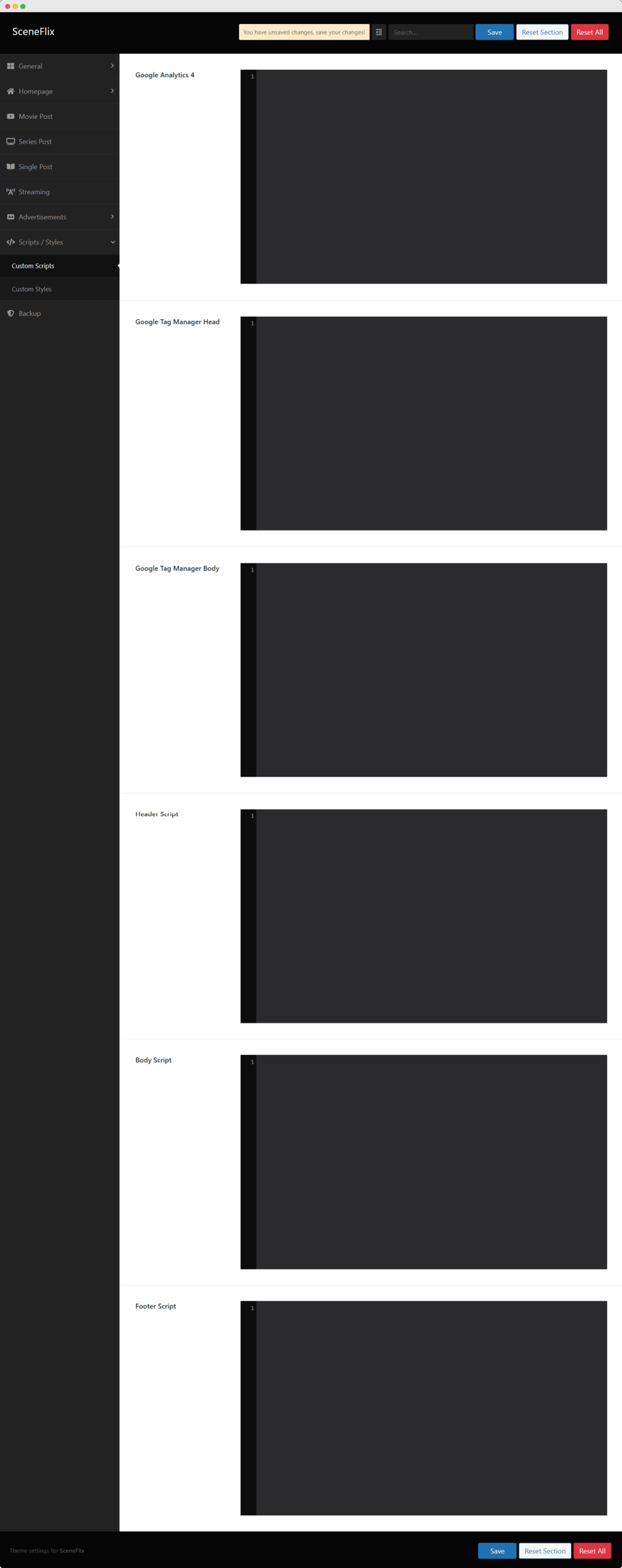
Developers can implement child theme architectures to preserve customizations during updates while leveraging the theme’s built-in customizer API and custom post type filters for advanced modifications.
The plugin’s modular architecture exposes action and filter hooks throughout the TMDB synchronization process, streaming server management, and content display functions, enabling seamless integration of custom features without core file modifications.
Custom CSS and JavaScript Integration Options
Advanced developers utilizing SceneFlix gain extensive customization capabilities through all-encompassing CSS and JavaScript integration options that extend far beyond standard theme customization panels.
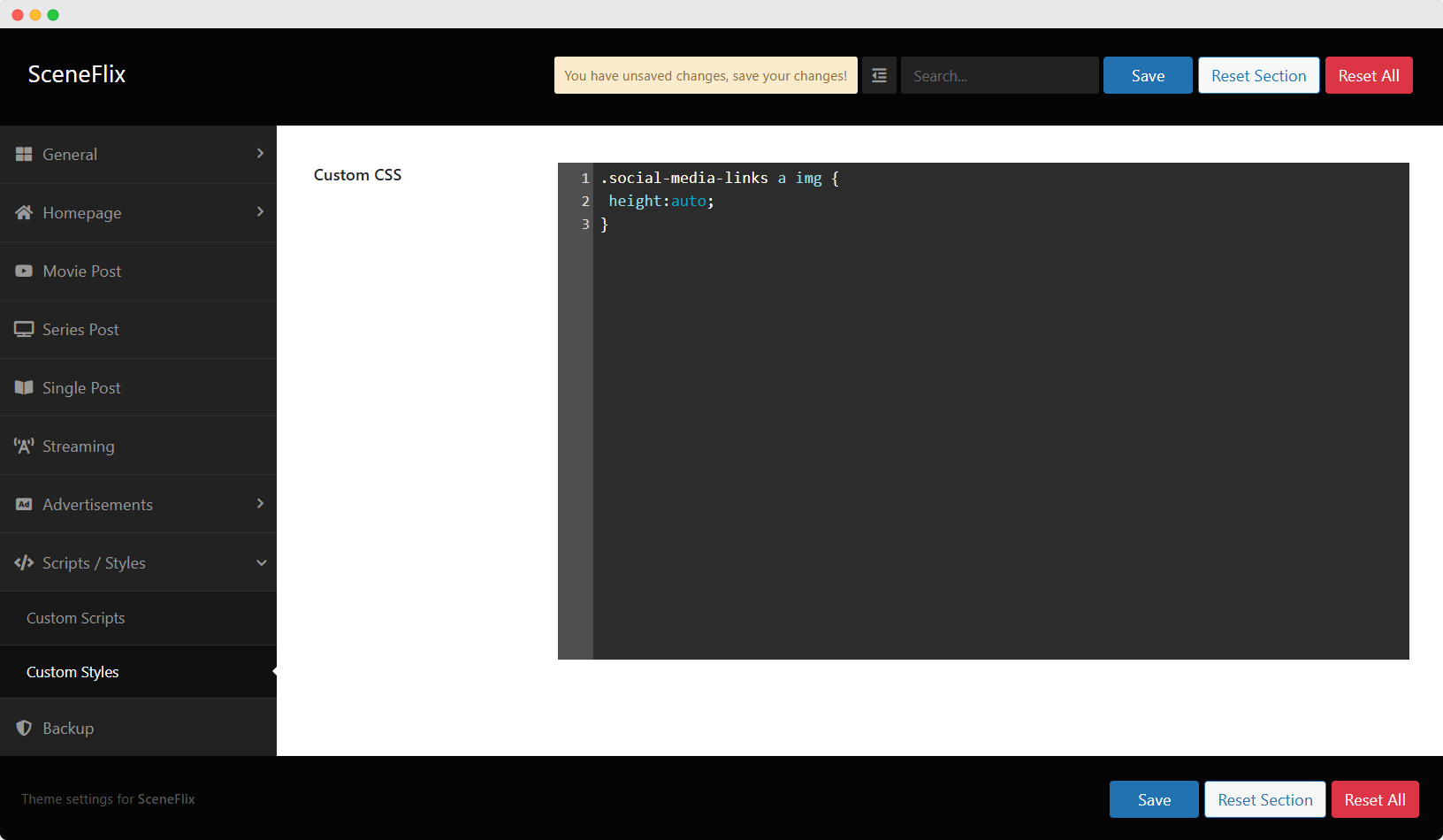
These custom CSS and JavaScript integration features enable sophisticated modifications to streaming interfaces, player controls, and user interactions.
- Custom CSS injection system – Override theme styles with granular precision targeting specific streaming components.
- JavaScript hook architecture – Implement dynamic player behaviors and real-time content manipulation functionality.
- API event listeners – Create responsive interfaces that react to TMDB data changes instantaneously.
- Advanced styling frameworks – Integrate Bootstrap, Tailwind, or custom design systems seamlessly.
Theme Customization and Child Theme Development
Building upon custom CSS and JavaScript foundations, WordPress child theme development represents the most sustainable approach for extensive SceneFlix platform modifications.
While preserving core functionality during updates, child theme development enables developers to override template files, customize PHP functions, and implement advanced theme customization without compromising the parent theme’s integrity or future compatibility requirements.
Plugin Extension Possibilities and Custom Feature Development
How effectively can developers expand SceneFlix’s core functionality beyond its default streaming capabilities?
The platform’s architecture supports extensive plugin extension through WordPress hooks, filters, and custom APIs, enabling sophisticated custom feature development that transforms basic streaming into thorough entertainment ecosystems.
- Custom Payment Gateway Integration – Implement subscription models, pay-per-view systems, and cryptocurrency payments
- Advanced Analytics Dashboard – Track user behavior, content performance, and revenue metrics with real-time reporting
- Social Features Module – Add user profiles, watchlists, ratings, reviews, and social sharing capabilities
- Content Recommendation Engine – Deploy machine learning algorithms for personalized content suggestions
Launching Your Streaming Platform and Marketing Strategies
With the SceneFlix platform development complete, administrators must execute thorough pre-launch testing protocols that validate TMDB API integration, streaming server functionality, and user interface responsiveness across multiple devices and browsers.
Quality assurance procedures should include systematic verification of movie metadata accuracy, episode navigation sequences, and advertisement placement configurations to ensure maximum user experience upon deployment.
Successful platform launch requires implementing targeted marketing strategies that leverage SEO optimization, content marketing, and strategic partnership development to establish audience acquisition channels and drive initial traffic to the streaming service.
Pre-Launch Testing and Quality Assurance Checklist
Before launching a SceneFlix streaming platform, administrators must execute thorough quality assurance protocols to guarantee ideal user experience and system reliability.
The testing phase requires systematic verification of TMDB API data accuracy, streaming link functionality across all configured servers, and validation of movie metadata display consistency.
Critical testing components include cross-browser compatibility validation, mobile responsiveness verification, and performance benchmarking under simulated traffic loads to identify potential bottlenecks in database queries and API response times.
Content Verification and Link Testing Procedures
After implementing the core SceneFlix functionality and configuring streaming servers, administrators must execute thorough content verification protocols to guarantee peak platform performance before public deployment.
These systematic procedures validate content integrity and streaming reliability across all platform endpoints.
- Automated TMDB metadata synchronization verification – Validate poster images, plot summaries, and cast information accuracy.
- Multi-server streaming link testing – Execute comprehensive endpoint validation across all configured streaming sources.
- Cross-device functionality assessment – Verify responsive design and streaming performance on mobile, tablet, and desktop.
- Database integrity validation – Confirm proper taxonomies, custom fields, and relational data structure implementation.
Cross-Browser and Device Compatibility Testing
Following successful content verification procedures, platform administrators must execute thorough cross-browser and device compatibility testing protocols to guarantee universal accessibility across all user environments.
Cross-browser compatibility validation encompasses Chrome, Firefox, Safari, and Edge testing scenarios. Responsive design verification includes mobile phones, tablets, and desktop configurations.
CSS grid layouts, JavaScript functionality, and media queries require systematic testing across viewport dimensions to make certain of consistent SceneFlix performance.
Performance Testing Under Different Load Conditions
While thorough compatibility testing validates cross-platform functionality, performance testing under varying load conditions reveals critical bottlenecks that could compromise the SceneFlix platform during peak usage scenarios.
Systematic scalability assessment guarantees streaming continuity during traffic surges.
- Concurrent user simulation – Test 500+ simultaneous streams to identify database query limitations
- TMDB API rate limiting – Validate performance optimization under API throttling constraints
- Memory consumption monitoring – Track WordPress resource usage during bulk content imports
- Server response degradation – Measure scalability thresholds before streaming quality deteriorates
Marketing Your New Streaming Platform Effectively
Marketing a SceneFlix-powered streaming platform requires implementing exhaustive SEO strategies that leverage schema markup, optimized meta tags, and TMDB-integrated content to compete against established services in search rankings.
Social media promotion involves automating content syndication through WordPress hooks and API integrations to distribute movie trailers, release announcements, and curated collections across multiple platforms simultaneously.
Community building centers on implementing user engagement features such as review systems, watchlists, and discussion forums that integrate with the SceneFlix database structure to foster audience retention and organic growth.
SEO Strategies for Competing with Established Streaming Services
Although established streaming giants like Netflix and Amazon Prime Video dominate search rankings through massive content libraries and brand authority, WordPress-based SceneFlix platforms can achieve competitive SEO positioning by implementing targeted technical optimization strategies that leverage long-tail keywords, niche content targeting, and superior site architecture.
- Schema markup implementation – Deploy movie/TV structured data for rich snippets that outperform generic streaming results.
- TMDB API metadata optimization – Transform raw API data into SEO-optimized content with custom descriptions and localized keywords.
- Niche vertical targeting – Focus on underserved genres or regional content where established platforms have weaker SEO presence.
- Technical performance superiority – Implement faster loading speeds and mobile optimization to surpass slower enterprise streaming sites.
Social Media Marketing and Content Promotion Techniques
SceneFlix developers achieve best content visibility through strategic social media automation that integrates WordPress hooks with platform APIs.
This setup enables automated post generation whenever new movies or TV shows are imported via the TMDB API integration.
Advanced content marketing workflows leverage custom PHP functions to schedule cross-platform social media promotion.
These workflows automatically generate engaging posts with TMDB metadata, trailers, and promotional imagery for ideal audience engagement.
Building an Audience and Creating Community Around Your Platform
Why do streaming platforms achieve exponential growth while others stagnate with minimal user engagement?
Building an audience requires strategic community-focused implementation beyond basic content delivery.
Creating community through SceneFlix involves:
- User-generated content systems – Reviews, ratings, watchlists driving engagement
- Social sharing integrations – One-click sharing amplifies organic reach
- Personalized recommendation engines – Algorithm-based suggestions increase retention
- Interactive features – Comments, discussions, user profiles foster connection
Ready to Build Your Own Movie Streaming Site With WordPress and TMDB?

SceneFlix WordPress Bundle
View DetailsSceneFlix WordPress Bundle transforms your WordPress website into a professional movie and TV streaming platform. This powerful combination of SceneFlix Core plugin and theme integrates seamlessly with TMDB API to automatically fetch and organize movie/TV data. Features include automated content import, multi-server streaming support, advanced advertisement management, responsive design, and monetization tools. Perfect for creating streaming sites with minimal effort.
Purchase NowWrapping Up
Implementing a movie streaming platform through WordPress and TMDB API integration with SceneFlix operates like assembling a precision-engineered machine where each component serves a specific function.
The technical stack requires proper API authentication, database optimization, and CDN configuration to guarantee seamless content delivery.
Developers must configure caching mechanisms, implement responsive media queries, and establish secure user authentication protocols.
This systematic approach transforms WordPress from a basic CMS into a robust streaming infrastructure capable of handling enterprise-level traffic loads.

